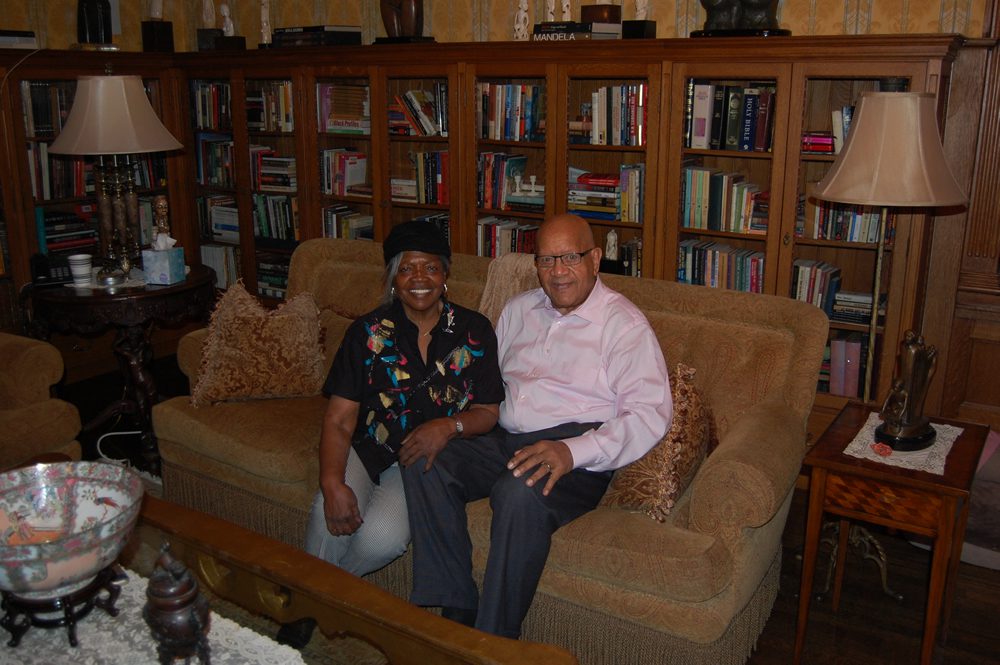
This article is a treatise about the visit of artist Stephen F. Condren, of Condren Galleries, to the historic home of James and Pauline Montgomery, which is the famous Goodman Mansion located in Kenwood/Hyde Park, Chicago. Mr. Montgomery is one of the leading attorneys in Chicago. His firm, James D. Montgomery & Associates Ltd. is located in downtown Chicago. James D. Montgomery is a personal friend of President Barack Obama.
Posted on Google+, Facebook, Twitter, Linked-in, and Tumblr.

The Historic Goodman Mansion
Below is an image of the Queen Anne mansion on Greenwood Avenue in Kenwood, Chicago. If you look carefully you can see the exquisite architectural detailing of the house. For example, notice the intricate detailing of the brickwork, further yet, see the relief work below the Master Bedroom Suite on the second floor to the left. This gracious and lovely mansion is the most inviting and comfortable estate in Kenwood. The mansion is not austere like it’s grandiose colleague, the Dr. J. A. McGill Mansion on Drexel Boulevard, shown below.
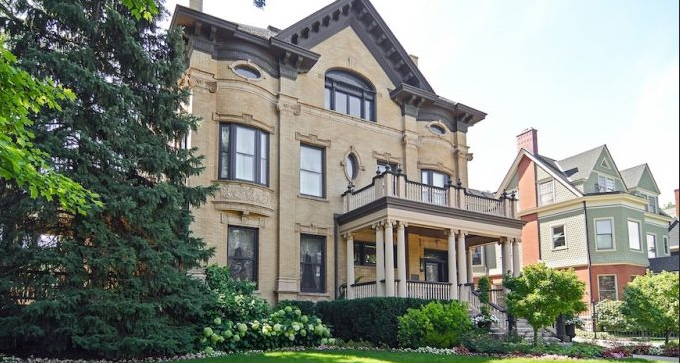
Historicity
Having grown up a short distance away in the Jackson Park Highlands, I have always loved and taken interest in Hyde Park, Kenwood, and the University of Chicago. I always say that I grew up in the shadows of the University of Chicago. In fact, the Jackson Park Highlands is in Hyde Park Township! I love the south side and I am thankful for all that she has given to me and our family.
My grandfather, Dr. Francis Leo Condren had is office in the same building as the first Walgreens, on the corner of 47th and Drexel Boulevard. A cute story that I may share here. A young lady that worked in Walgreens liked grandpa very much (everyone did). She would grab him by the collar and say “Dr. Condren, please buy stock in this company, it is going to be really big”. Of course, as fate would have it, he never did. Where would we be today?
St. Ambrose Church
My father grew in Kenwood and they were members of St. Ambrose Catholic Church on 47th and Ellis Avenue. We are an Irish Catholic family. With that, the south side is in my blood and still is. Every time that I am in the area the air gets better! It is my conviction that the south side of Chicago is the finest place to live in Chicago. The south side has everything, the University of Chicago, Lake Michigan, outstanding real estate, and the safest neighborhood in Chicago.
Dr. Francis Leo Condren
My grand father, Dr. Francis Leo Condren, who raised his family in Kenwood, made the comment to me when I was a young man in High School. Because “We never had access to these great homes”, and now because of Mr. & Mrs. Montgomery I am the first in our family to have such access, and what an honor indeed.
James Corwin Condren
My father, attorney James Corwin Condren, grew up in Kenwood and would often take us to the University of Chicago to go ice skating on the Grand Plaisance and through his old neighborhood. Dad loved the Loeb mansion and I know that it was from him that I also took to the place. I even remember as a boy, dad driving the family by the Loeb house at night. We were going south on Ellis Avenue and he pointed out the lights in the house, which I vividly remember as I sat by the window of the car fixed on the great edifice.
Kenwood
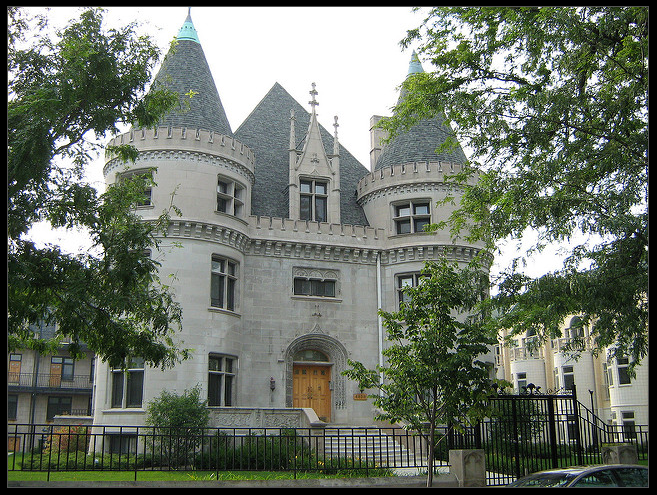
The Chicago District of Kenwood, is a political district that runs between 43rd Street and 51st Street for the north and south borders. On the western border is Cottage Grove Avenue, and the eastern border is Lake Michigan. Most importantly, the area of note in Kenwood is between Woodlawn Avenue and Drexel Boulevard as east and west boundaries. In the area between 51st Street and 47th for the north and south boundaries.
This area is the estate section of the district and one of the most fashionable and sought after communities in the Chicago metropolitan area. Kenwood has always been the premier residential community on the south side of Chicago, complimenting its rival Evanston to the north. Like it’s rival Evanston, Kenwood is fortunate to be adjacent to a world class institution of higher education, The University of Chicago.
Estate Mansions
Most importantly, this fashionable area is the site of many famous and beautiful mansions, built by the leading families of Chicago. When the area was originally chartered the acreage or parcels of land were divided into extensive lots for the construction of large estates. It must be understood that at this time there was no electricity and horse and buddy were the mode of transportation. The vastness of the properties can be seen below.
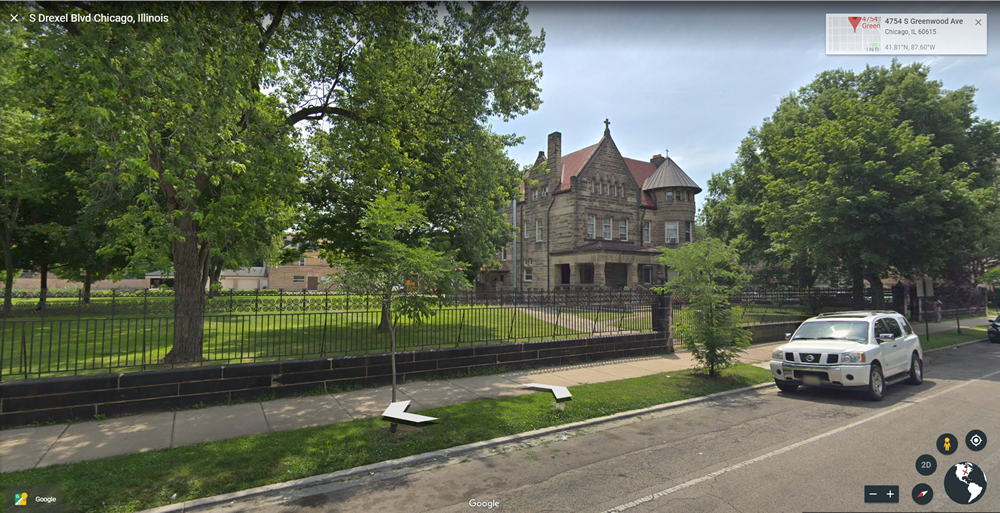
Large Homes
The homes built here were very large and accommodated a large, full-time service staff that lived on the premise. Further, the need for housing of horses and carriages was the staple of the, much as garages and car ports of today. Many of these homes had porticoes for the alighting of company upon arrival. Of the many fine and beautiful mansions that were built in Kenwood at the turn of the 19th Century, there is one that stands out from all the rest, the William O. Goodman estate.
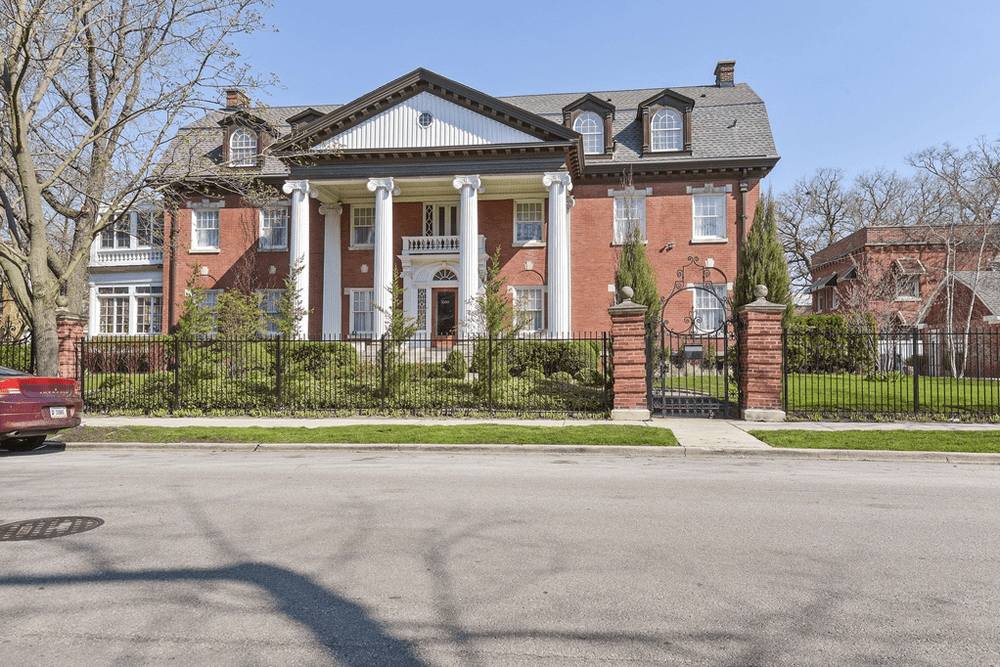
Goodman Estate
The Goodman estate, at 5026 S. Greenwood, was built by William O. Goodman, a lumber magnate of the late 19th Century. Upon the death of his son, Kenneth Sawyer Goodman, he donated a large sum of money to establish the Goodman Theater in Chicago. This fine property is now the home of James and Pauline Montgomery.
Because this home is historic and cannot be replicated, no matter how much moderns try and ultimately fail. Their significance lies in the intrinsic worth and merit of their place in a time that is unique. Because many producers attempted to make a “new versions” of an old classic, they turn out to be pure folly. Beethoven’s 5th is a classic and must be understood in context of the time in which it was written, so too, for this very great, and rare house that I had the honor to visit.
Because this is a great house it will always be a great house. Most importantly, the only thing that is greater than this house are those that dwell in it. To this day there has been no greater resident to dwell in this home than James and Pauline Montgomery!
Invitation
I was graciously given invitation by Mr. Goodman to his home at 1:00 PM, on Saturday, March 9, 2019. This is a day that I will always remember and hold dear to memory. This article is a brief treatise about my visit that was most graciously extended to me by Mr. Montgomery. In other article that will follow this one, I will cover the extensive history and pictography of this historic and famous mansion. All of the photographs in the article are mine and are open to public domain
The Visit
My visit to the Montgomery’s was prompted by my letter to about the famous Loeb Mansion, right behind his house in Kenwood. The juxtaposition of the two great estates was a call to arms for me and so I had to act! In my letter to Mr. Montgomery I enclosed copies of the now famous Architectural Renderings that I did of the Loeb Mansion, which are now in the permanent collection of the Chicago History Museum.
The Loeb Mansion
The Loeb mansion was the home of Albert Loeb, a Vice President of Sears Roebuck, and father of Richard Loeb, famed by the 1924 murder trial of Leopold & Loeb, with attorney Clarence Darrow. In the summer of 1972, house was raised, and two new homes are on the site. The red brick and stone, exterior wall that surrounded the Loeb mansion is still there.
Architectural Renderings
The renderings were done as a final project for Mr. Jorgenson’s Architectural Rendering class, in 1971, at the College of DuPage, in Glen Ellyn, Illinois. Mr. Jorgenson commented that “These are the finest renderings that I have ever seen.” As I stood there, he then penciled in small fine print “100” on the bottom right hand corner of each of the renderings. Below are images of the two renderings.
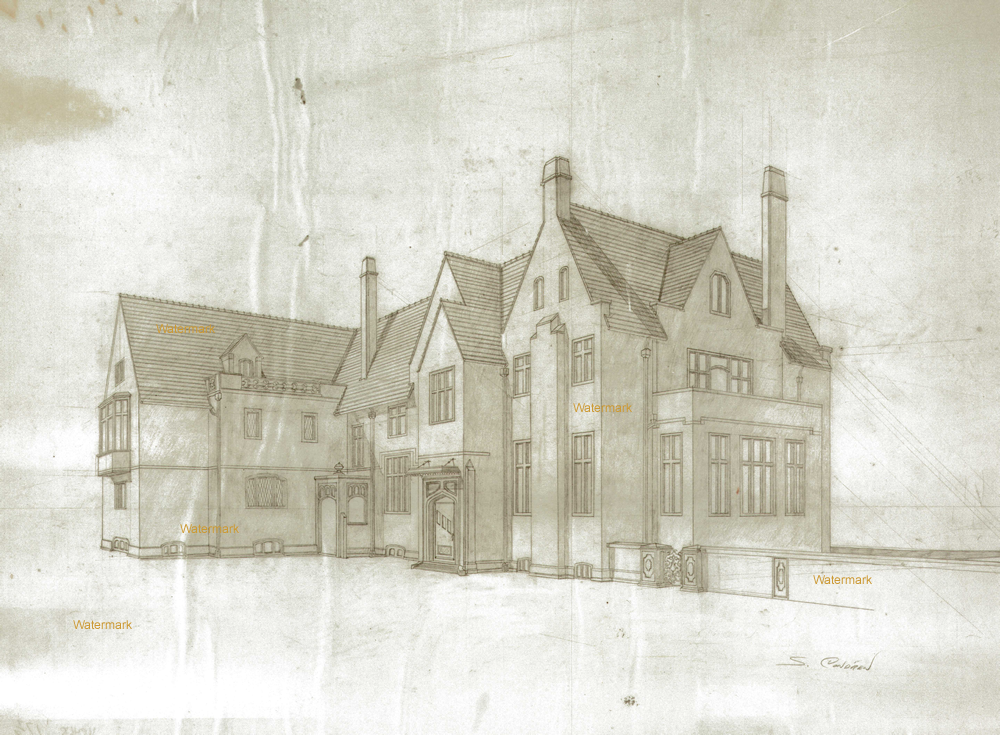
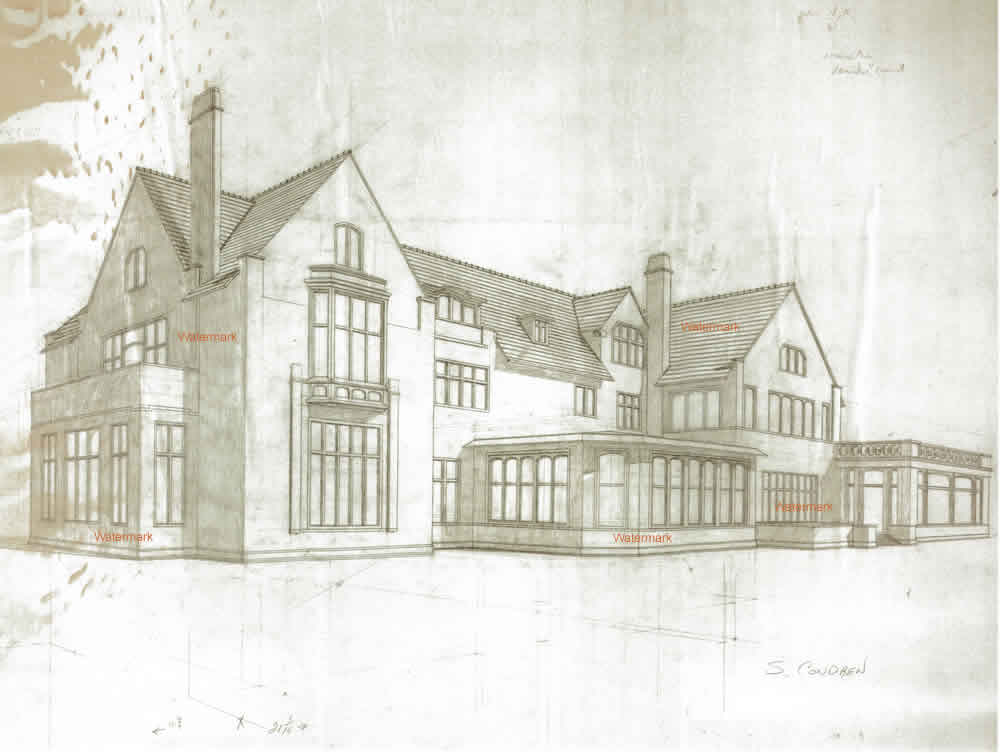
Loeb Mansion Photograph

Sites of Loeb Mansion and Montgomery Mansion
As you can see from the plat of the sites below, the Loeb Manion was directly adjacent the Montgomery Estate. Two home now stand on the sit of the Loeb Mansion that was raised in the summer of 1972. When the Montgomery Mansion was first built, by Mr. William Goodman, the property encompassed from the corner and including all of President Obama’s home, and up to the top of the Loeb estate.
Site Sizes
The Goodman estate was actually twice the size of the Loeb estate! As time passed the property was subdivided, as many in Kenwood were. The same hold true in the Jackson Park Highlands.

From the perspective view below you can get a better understanding of the sites, however, the receding vanishing points cause a distortion in both the proportion and scale of the properties. Thus the Obama site looks almost as large as the Loeb estate.
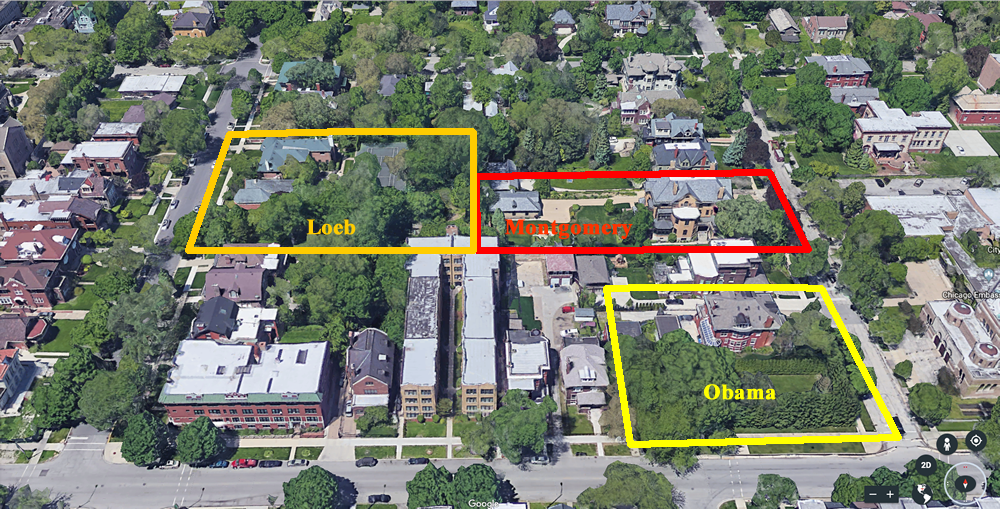
Loeb Mansion Original Fence & Posts
You can clearly see from the photo below the fence and posts are still intact. However, there is one missing post, and that is the one on the left side of the side walk that leads through the gate and up to the new house that has taken place of the Loeb Mansion. The driveway and walk are correct in placement from the Loeb Mansion. I have photos of the gates in my files that I will have to look up to prove this point. More importantly, I clearly remember the posts on either side of the walkway.
Lot Size
Clearly, even with the distorted perspective you can see that this is very large estate! The house that stands there now is in the same exact spot as the Loeb Mansion was situated on the lot. However, there is another house adjacent this one, that is not in view that I think is all part of one complex. This adjacent house can be seen from the roof-top in the aerial photos above.
Tennis Courts
The tennis court that you can see in the aerial photo is not from the Loeb estate, however, the Loeb’s did have a tennis court in the rear of the property, closer to the wall, and I do not think as large as the one that is in view here.
South Lawns
In any case, all the property to the right, or south, where the south lawns and gardens and the Loeb Mansion took in all of this vast space as a private retreat. The lower architectural rendering above shows the garden façade looking southward onto the lawn and gardens. The large structure that comes out from the center of the house is the solarium. The set of windows seen behind, are to the Dining Room. The Living Room took up the entire west wing, and the Master Bedroom Suite was above the Living Room. The bathroom of the Master Bedroom Suite was on the north face of the west wind, and can be seen from the façade rendering above.
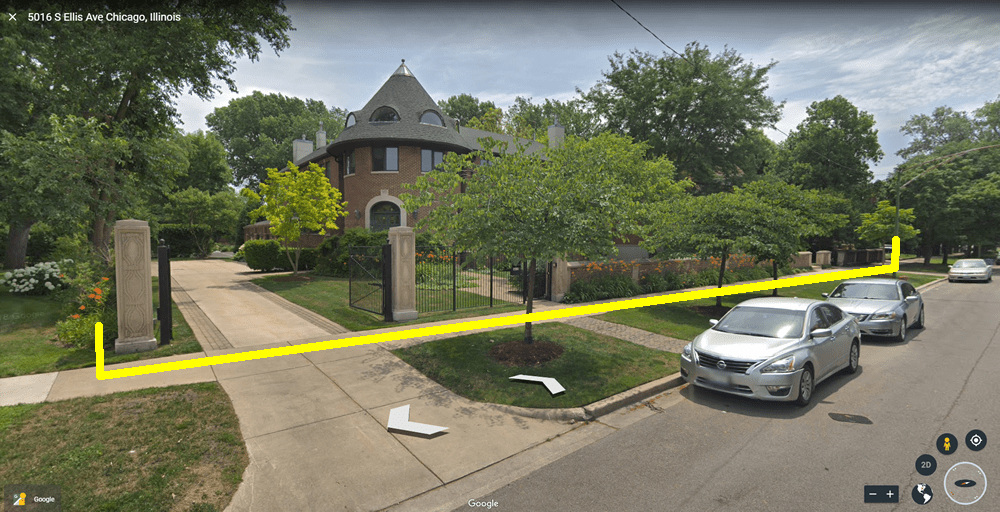
Pauline Montgomery
Having grown up not far from here, at 6841 S. Bennett Avenue, in the Jackson Park Highlands, I knew how to time my journey. Shortly before 1:00 I drove down South Greenwood Avenue to park and meet the Montgomery’s. As I drove towards my destination I could see barriers in the street, with access cautions! I carefully drove through the barricade and parked across the street from the Montgomery’s.
The Approach
I approached the street front gate and range the bell. Immediately a buzzer unlocked the gate permitting me access to the upper lawns and entrance to the house. Quietly, I walked up to the front door and rang the bell. I waited and then slowly the door opened and then appeared the gracious figure of Pauline Montgomery. I introduced myself and she reciprocated. Immediately Pauline make me feel comfortable and at home. In such an auspicious and august house that is not the usual feeling one has upon entry!
James Montgomery
Pauline informed me that her husband was out at a funeral and would be home shortly. I of course understood and thanked her for letting me in. We then walked into the Entrance Hall where Pauline started to share with me the history and details of the home. As she talked we went from the Entrance Hall through the Dining Room and then into the Grand Staircase. Upon standing in front of the great staircase Mr. Montgomery came in from the Carriage Entrance at the side of the house and introduced himself to me. I reciprocated as I assisted him with his coat.
Jackson Park Highlands
We then walked together to the Parlor and engaged in a gracious and enlightening conversation. It was here that Pauline shared with me that they used to live in the Jackson Park Highlands, on Constance, my old neighborhood. We lived at 6841 S. Bennett Avenue, our house was next to Mrs. Roberts at the corner of 69th and Bennett. The façade and aerial view of our home is pictured below.
Mr. & Mrs. Roberts
Mrs. Roberts has the largest lot in the Jackson Park Highland with 7 city lots. Mr. Roberts was the developer of the Jackson Park Highlands. The property has a chauffer’s quarters above the garage, and a turn table in the garage so that Robert, her chauffer, could drive straight out!
Below you can see Jackson Park with the green lawns and harbor. The southern border is 67th Street, and circled in red is the Jackson Park Highlands.
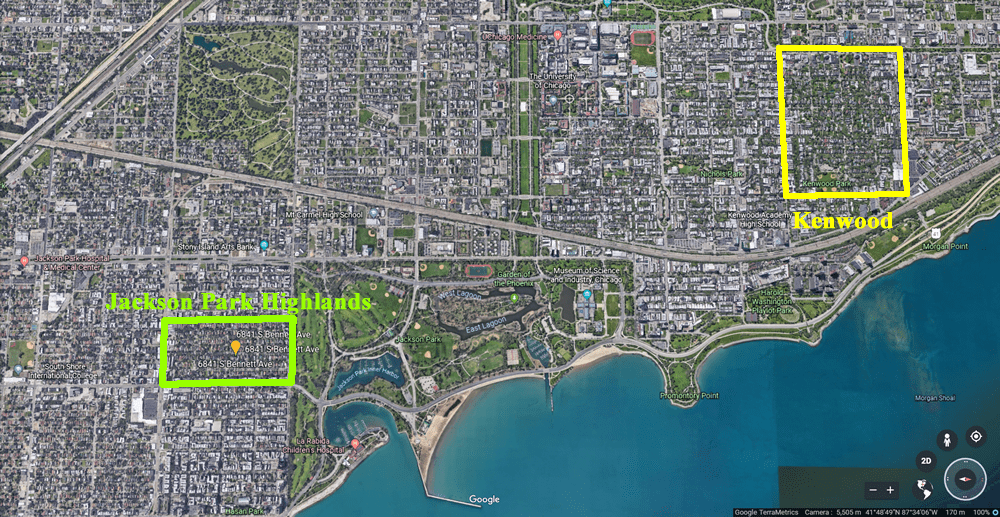
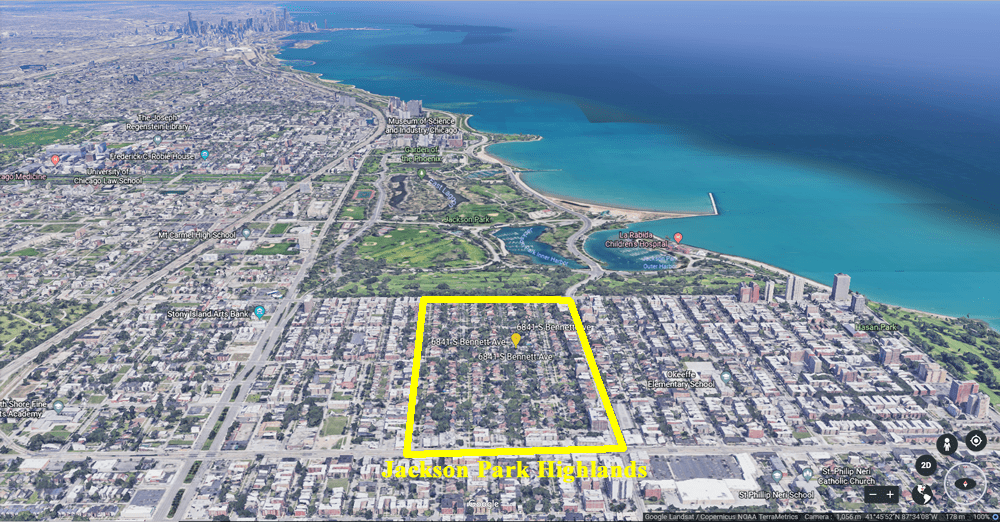
To the left is Mrs. Robert’s home. She has the corner lot and a 2-story garage with chauffer’s quarters. There is a turn table in her garage to rotate the car.
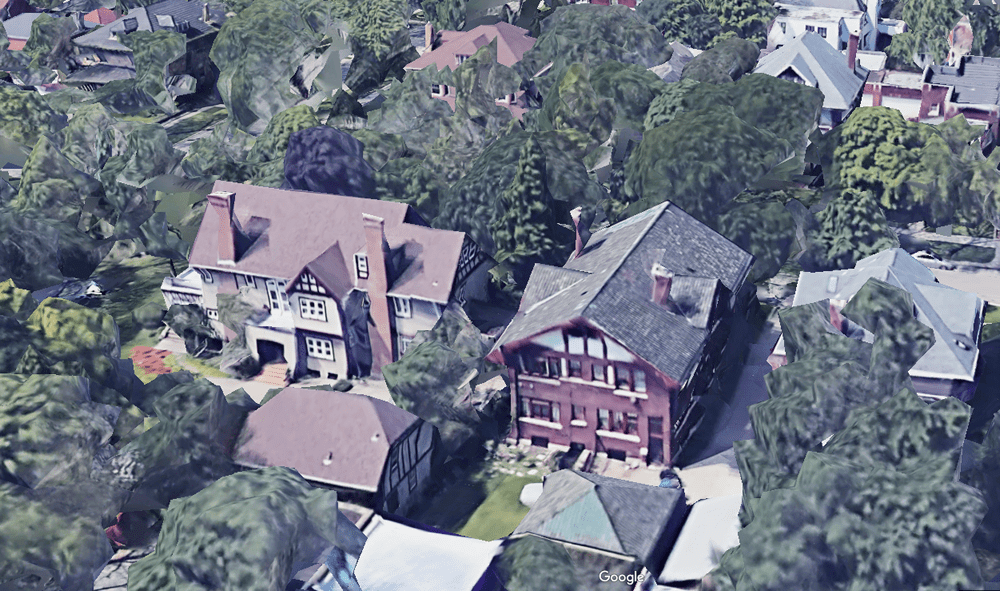
Our garden lot was sold off years before we came. To the left is the Lemonthals house, which occupies that spot.

Neighborhood Friends
We then, with delight talked about people that we both knew, Jesse Jackson, Ramsey Lewis, The Sherman’s, and James & Virginia Spears, of Spears Transportation. Pauline said that she know the Spears’s by name, but that had left by the time they had move into the Highlands. The Spears’s lived just two blocks on the street on Constance.The Spear’s son, Jory Spears and I were best friends growing up and we still are as you can see from the drawing that I did of us, at Lou Mitchell’s Diner, below.
Jory Spears and Stephen F. Condren
Here is a drawing that I did of Jory and I have lunch at Lou Mitchell’s.
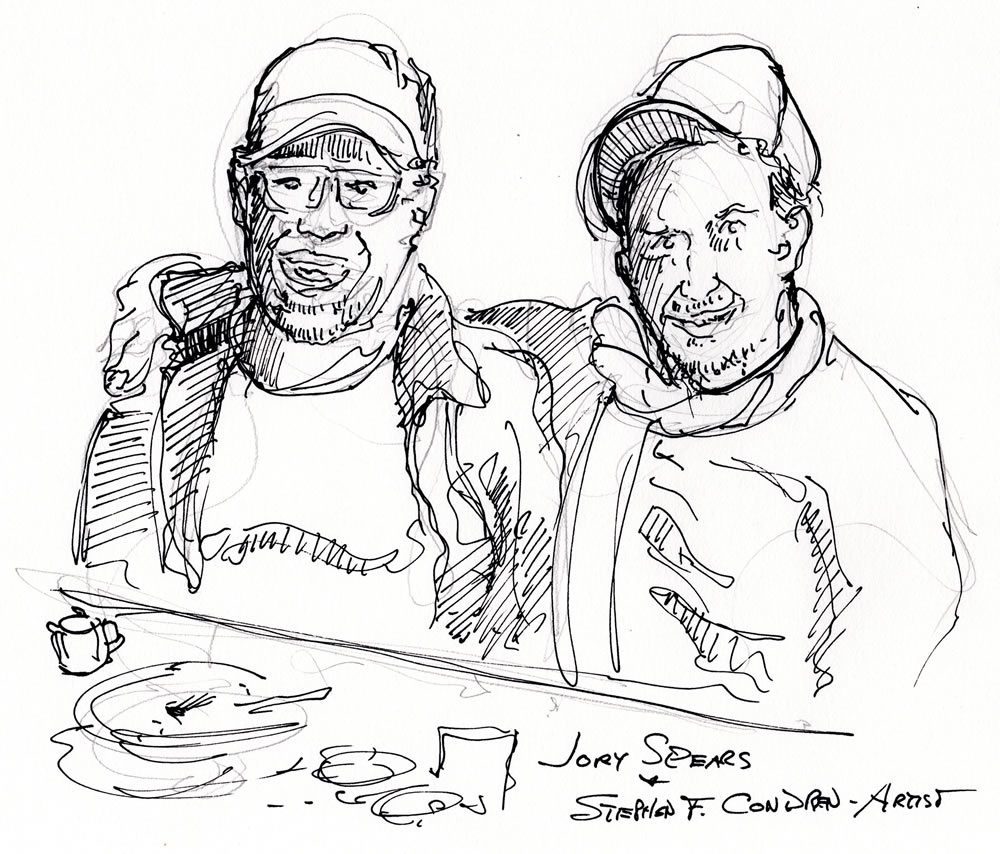
The Spears House
As you can see from this photo, the Spears owned one of the original homes. The house to the right is on their garden lot and is clearly a newer structure. Notice how the Spears’s house is designed to face the garden lot. Their back door is on the opposite side of the house, and almost aligned with main entrance. The house on the left side is also an original home and it’s garden lot is also taken up by a newer home to the left, as well. A key element to knowing which house is original is the use of ornamental stone masonry.
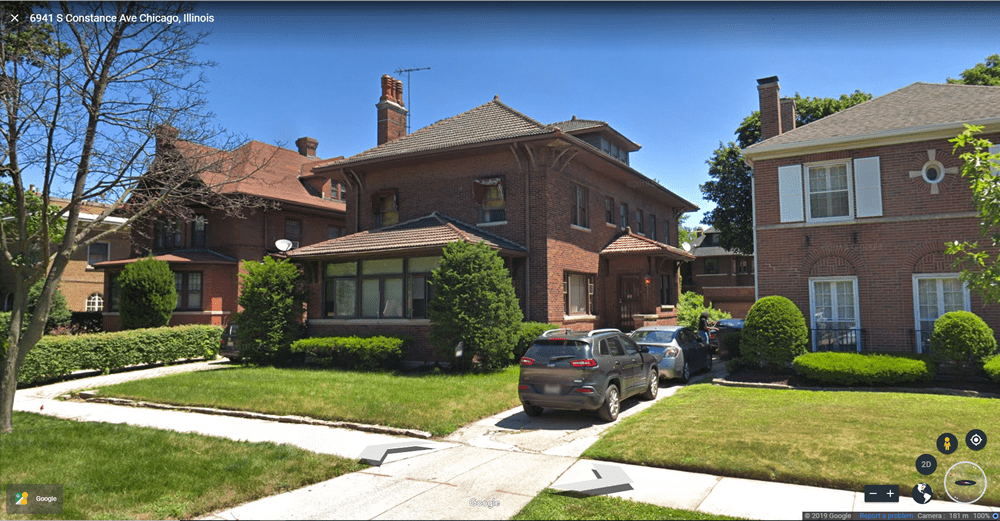
The Howlett’s
Just five doors to the north of us lived our good friends and St. Philip Neri classmates the Howlett’s. Michael Howlett was the State Auditor while living by us in the Highlands and soon became Secretry of State of Illinois. His second son, Robert Howlett and I were in the same class together at St. Philip Neri, so we grew up together.
Mrs Howlett (Helen) was a Geary, and her brother lived on the next block over on Constance. The Geary’s had eight girls and a son, Dickie, for the caboose. Dickie Geary and my brother Philip were best friends all through school at St. Philip Neri. My grand parents, Dr. Francis Leo Condren and Margaret were very close friends with the senior Geary’s, from the South Shore Country Club, which we all belong to.
In the photo below the large doors with sconces on each side lead from the living room to the front terrace which used to have a balustrade and large green aweing that stretched from the door to the morning room on the right side. The living room was very large and took up the entire front of the home. The ballroom was on the third floor.
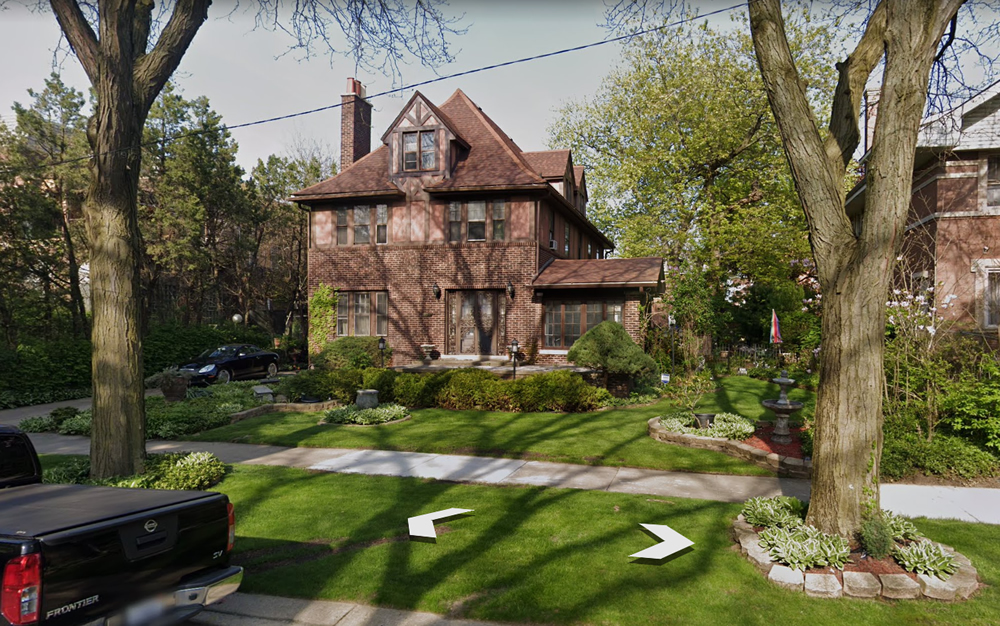
Reverend Jesse Jackson Home
Below is the home of the Reverend Jesse Jackson, who as of this date still lives in the same home as I knew him when I grew up there in the Highlands. His home is the only house in the Jackson Park Highland with an elevator. This is a Tudor style mansion facing the garden lot to the south. Right next door to the right (you can see the corner of the house on the right) is the home of Ramsey Lewis, of the Ramsey Lewis Trio.

Ramsey Lewis
Below is the home of Ramsey Lewis. While he was living in the Highlands when we did, he always had a fleet of Cadillac Eldorados in his driveway.

The South Shore Country Club
It would be remiss to leave out the common bond to many of us from both St. Philip Neri Parish and the Jackson Park Highlands, and that is the magnificent South Shore Country Club. The club, which sits on the shores of Lake Michigan between 67th Street and 71st Street is now a landmark and the place of President Barack Obama’s wedding reception! I grew up at the South Shore Country Club and learned to swim there and at the Chicago Athletic Association (CAA), downtown on Michigan Avenue.

Garden Lots
Below is one of the remaining section of homes in the Jackson Park Highlands with their gardens lots. This is how the Jackson Park Highlands was designed and should look like. A private garden lot for each house. The house on the left does not belong here. This house is sitting on the garden lot of the house just to the left of it, which is out of sight in this photo. Just imagine the space and privacy of the original conception for the Jackson Park Highlands!

The Sherman Family
Nathan Sherman
Mr. Nathan Sherman was the Chairman and founder of Midas Muffler Corporation, he lived across the street from us. Below is a photo of his home.
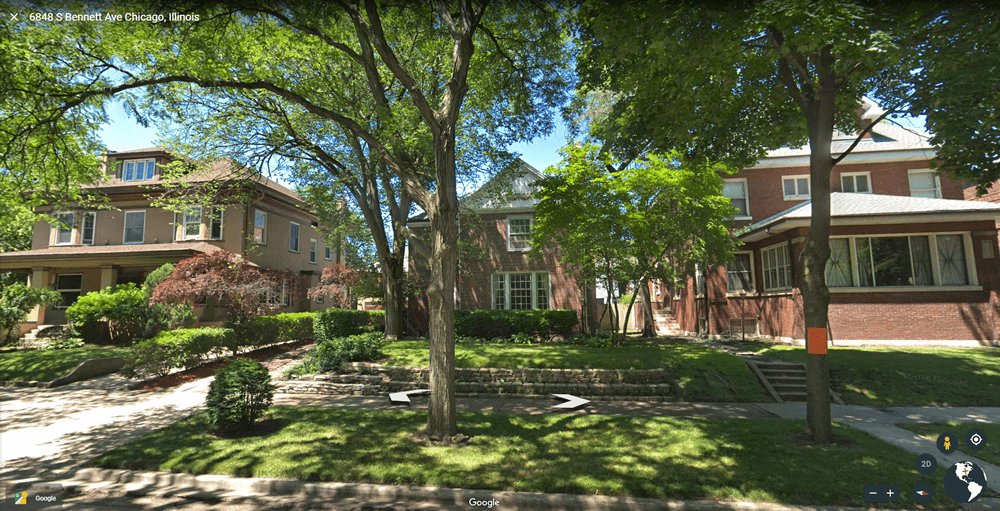
The Grazing Calf
It was with delight that I shared my story of the Sherman family cow! Across the street from us lived Mr. & Mrs. Nathan Sherman, Chairman and owner of Midas Muffler Corporation. They owned a black Silver Shadow Rolls-Royce which was prominently displayed in their driveway. Their son, Gordon Sherman, and President of Midas Muffler, lived just one block north of us.
Garden Lot
Gordon Sherman’s property still had the garden lot from the original layout of the Jackson Park Highlands, so they had a large parcel of land. When the Jackson Park Highlands was developed, it was intended that each home had an adjacent “garden lot” for privacy. As time passed people would sell off the garden lot. There are still garden lot properties as you can see below, but they are few.
The Calf
On that land they kept a calf! Our friend Louis Balch, who lived next door to the Sherman’s, would let us come over and pet the calf from between the garages adjacent the Sherman’s property. How they were able to have a calf on city zoned land still to this day is a puzzle to me. However, I will always remember all of us going over to the Balch’s to pet the calf. Below is a photo of their home.
Gordon Sherman
Louis Balch lived in the red house to the left, and the Sherman’s to the right. In the center is the Sherman’s garden lot, which can be noted by having the same fence. The calf was kept in the back of the yard, and to the left behind the Balch’s house is the Balch’s garage. It was there that the calf would walk up to us and we would pet it. The Balch’s garage opened on to 68th street, which then was adjacent the Sherman’s yard. Gordon Sherman’s home is seen below.
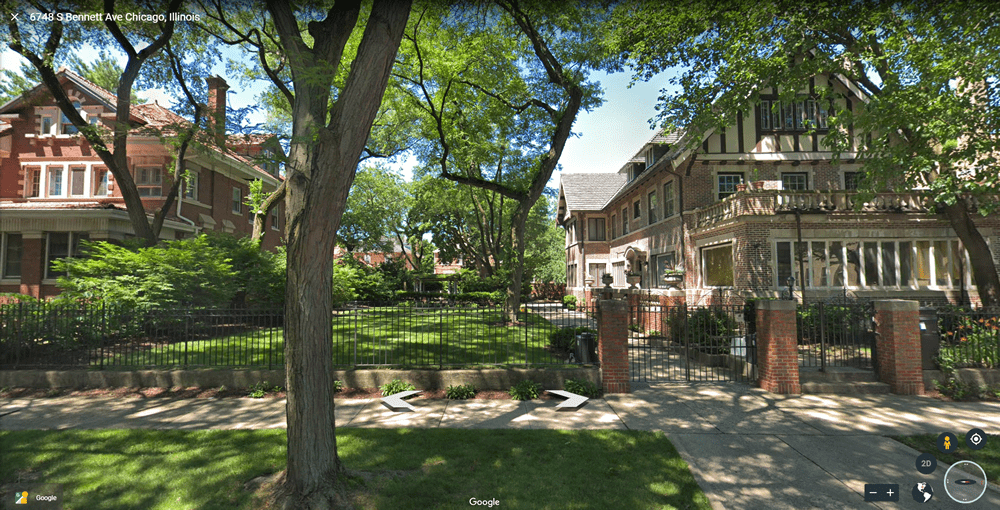
Leopold Shooting
When I was about 10 years old there was a shooting involving the Leopold family of the famous Leopold & Loeb murder trial. I remember hearing the gun shots early in the morning from the Guest Bedroom windows. From the back yard photo of your house above, the Guest Bedroom is located at the back left corner, or the southeast corner of the house, on the second floor. There are large French windows in this room and we can see directly over Mrs. Roberts lawns to the Leopold house.
The Victim
Immediately, Mom and I went out over to the site, which was around the corner on 69th Street. The victim was on the side grassy stone segment of the Leopold’s driveway. Mom actually went up to see if the man was OK, but she knew as she approached him that he was dead. She touch his leg with her left foot, then retreated, I stood back and watched. This was before anyone was around, police or rescue. For a long time blood stains remained on the decorative flat rocks along the right side edge of the driveway.
Just across 69th street, bullet shots were visible across the center of the picture window of the house opposite the Leopold’s on 69th Street. I remember this clearly, because the window remained intact, not shattered, and they were clustered in the center. Mom said that it was gang related between the Leopold’s and the neighbors across the street. How accurate this information is I cannot say as I was only a boy. Life in the Jackson Park Highlands!
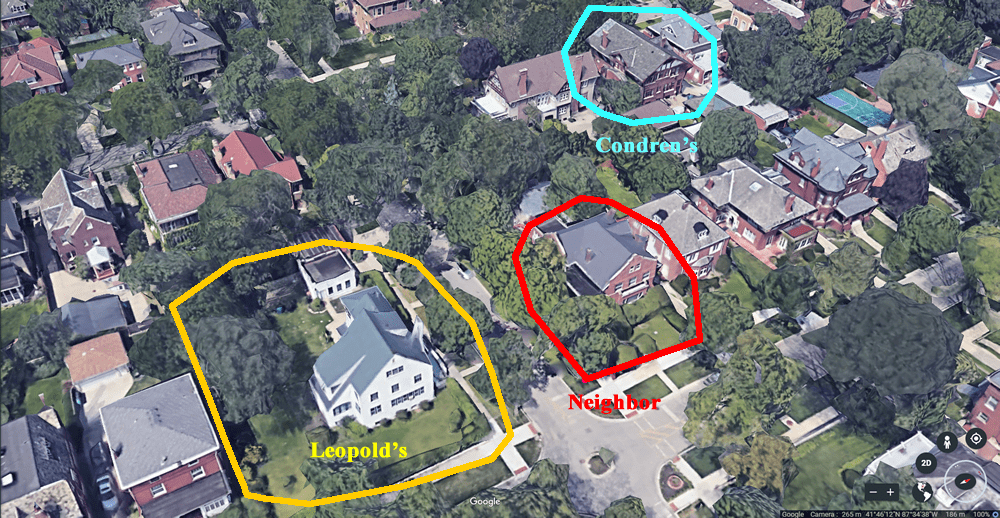
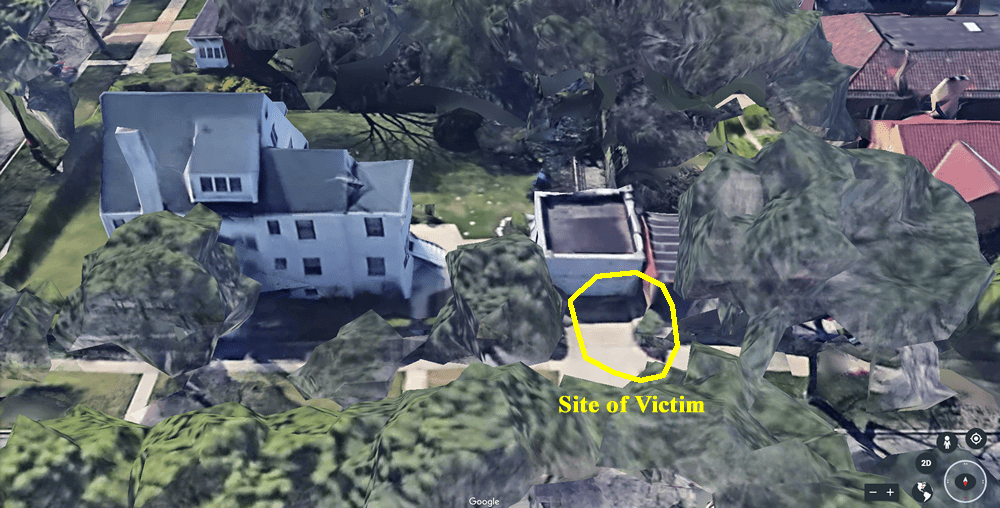
President Barack Obama
Aerial View
As we sat in the Parlor and talked the conversation went from excellent to amazing, when they had told me that they knew President Barack Obama who is their next door neighbor! That answered my question with regards to the barricades out front. With a stoke of humor I said, “I hope that when I leave, I won’t find my car triple booted and towed!”, at which they laughed and assured me that my car was safe. James then went on to tell that he held the first fund raiser for President Obama. You can imagine my amazement to all of this, who would have ever guessed?

A Lady Of Grace And High Station
What is most valuable to me, above all, are the vignettes of Pauline in segments of the photos, as they give real meaning to the house, and that being the soul of dear and precious people. Pauline is truly a lady of grace and high station!
Grand Tour
As Mr. Montgomery relaxed in his chair, in the Parlor, Pauline commenced with her grand tour of the house. The photographs below were taken by me as we walked through the interior of this great house. I have organized them by subject (room name) rather than by route (our path through the house). Now please enjoy the personable and rare view of a great house of great people.
The House
- Residence
This is the façade of the Montgomery home, a historic Queen Anne residence in Kenwood, Chicago. The house faces east and you can see the windows of the Ballroom on the Third Floor. The Ballroom takes up the entire east wing of the Atelier. The Master Bedroom Suites have command of the Second Floor, separated by the oval window in the center. The front entrance has the door to the right on the porch (which was gone and completely restored by the Montgomery’s). To the left of the front door are the windows of the Entrance Hall. The large windows to the far left are to the Living Room. The porch to the extreme left is for the Morning Room, which faces the south lawns.
Greatest Success
The greatest success of this fine home is it’s habitability. Unlike it’s later rivals of the electric light era, this house was designed and built to be lived in by a single family. The duality of the great home is remarkable. On the one hand this is the most comfortable and easy to live in homes that anyone could ask for. Yet, on the other hand, you are able, at a moment’s notice, to entertain 50 people with grace and polish. This is an amazing house!
House Is For Sale
The house is currently on the market. If there is one thing that I can say about this home it is that it is very comfortable and easy to be in. Of course the Montgomery’s can make even a jail cell a comfort, nevertheless, this home is pleasant and easy to live in. Not only is it easy to live in, it is gracious to entertain in, and entertaining in a house like this is relaxing.
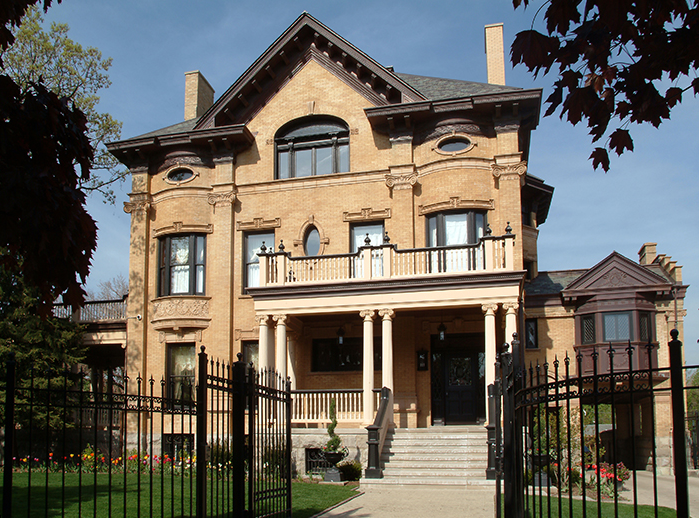
Living Room
- Drawing Room
The Living Room is the only room on the first floor without paneling, this was brought to my attention by Pauline. As you can see it is very formal and used only on rare occasions with the arrival of high ranking people and dignitaries. Even the head of the house does not use this room otherwise. Activities out side of this are done in the Parlor.
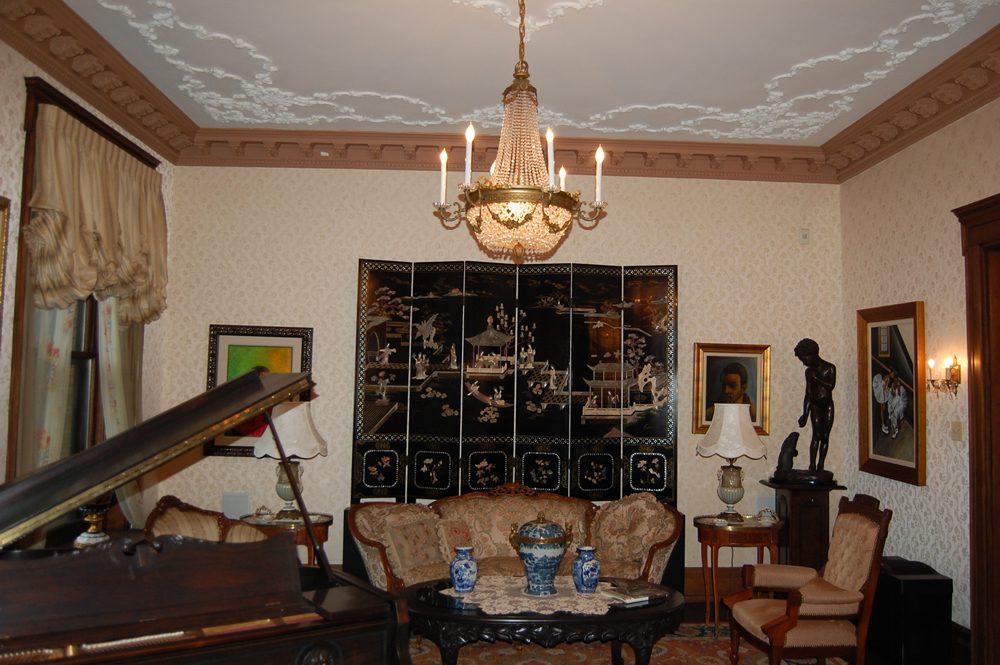
The Living Room is square and the Chinese partition is a perfect fit.

Grand Staircase
- Front Stairs
Wood
The Grand Staircase, or front stairs, have a dual purpose. First and foremost they serve as access to the upper floors of the house to the family. However, there is another vital role that they play, and that is public access from the Carriage Entrance to the Ballroom! That is why the stairs are so large and wide. You would have ladies in waiting escorting their mistresses to an elegant event. I love the shoes.
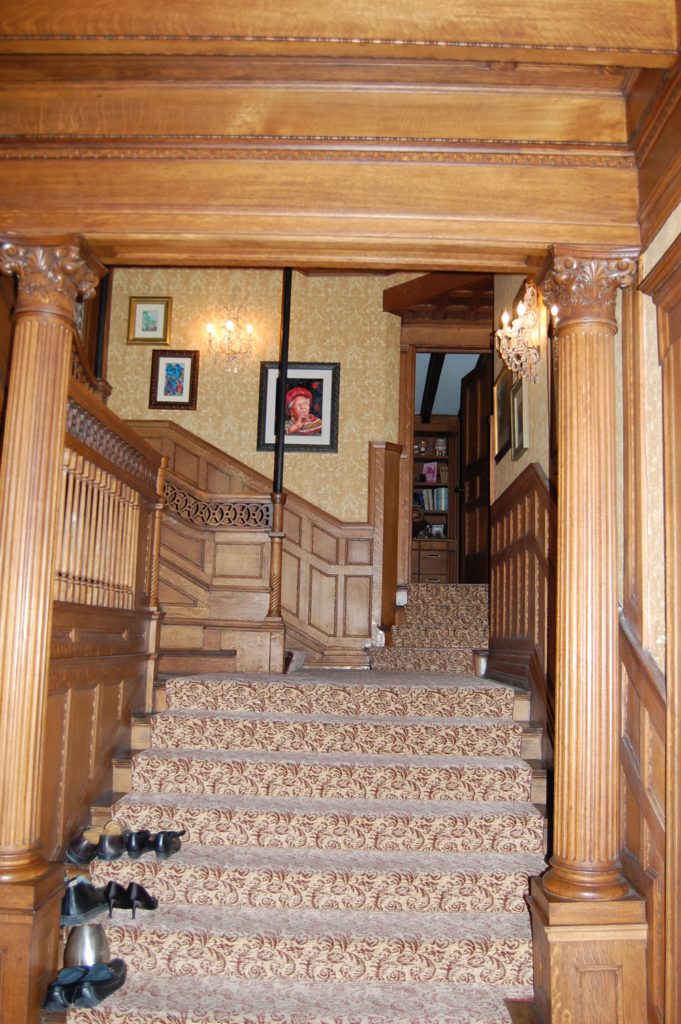
The rounded protrusion is a bench that can be seen from the staircase side.
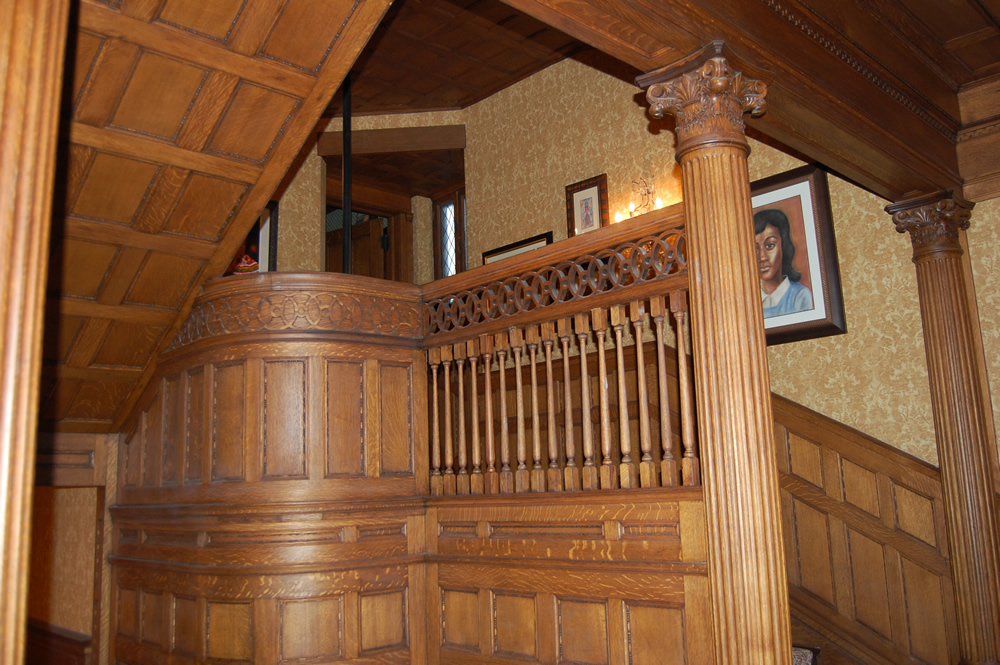
I would like to mention that the solid black posts were later additions that are supports from settlement. My thinking that is would be a great project for the next owner to find or manufacture fluted columns for enclose each of the steel beams.
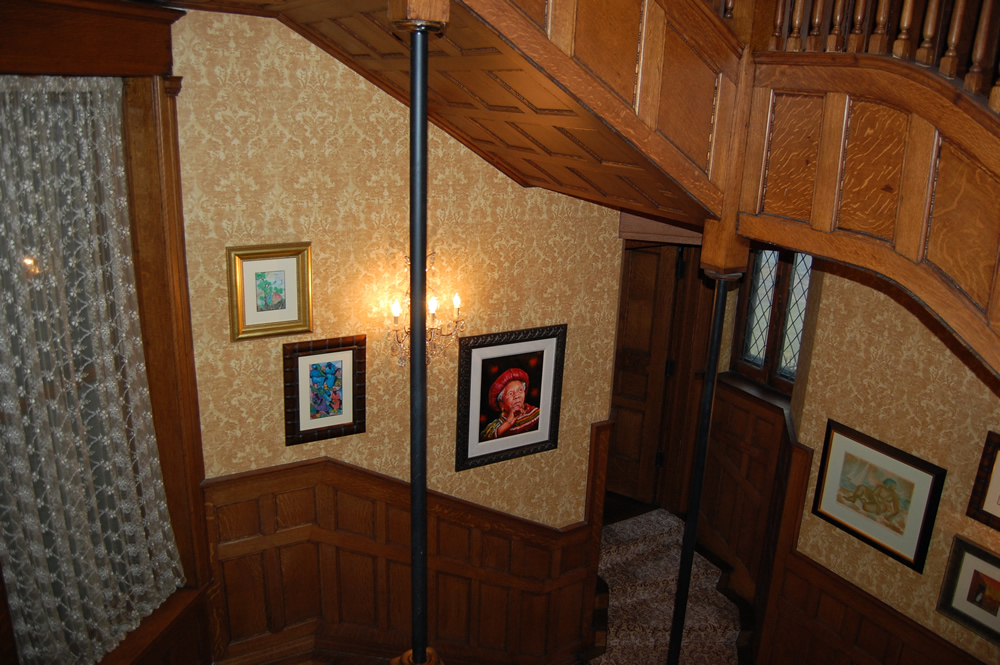
This photo of Pauline is taking us to the Master Bedrooms. We are standing on the Second Floor Landing which has an arrangement of a couch and chairs for guests to relax while waiting for the water closet.
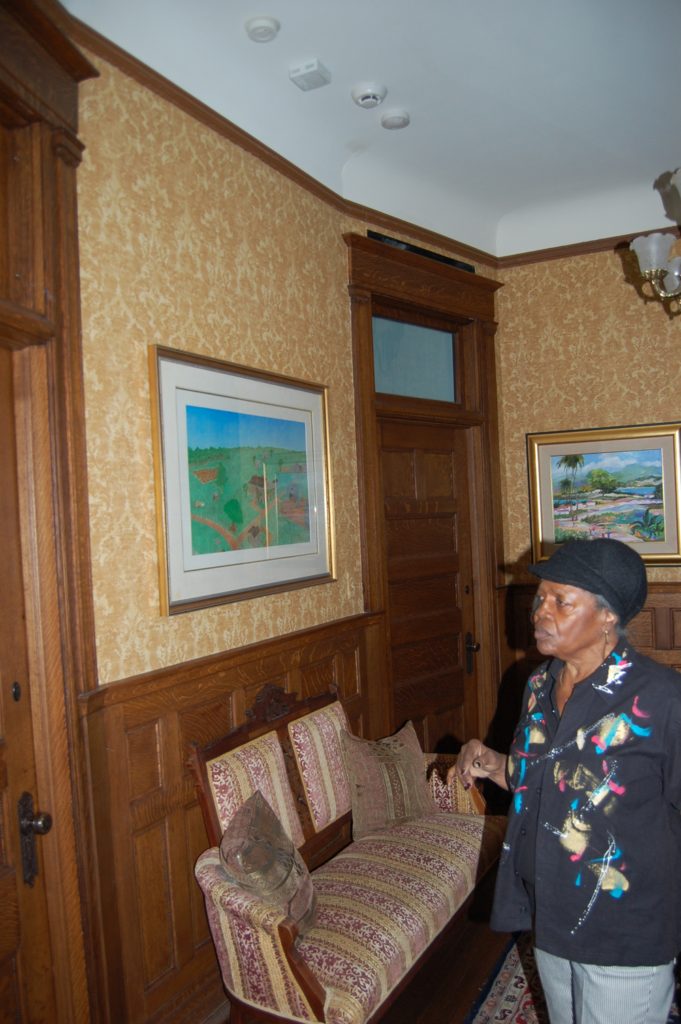
Stairwell
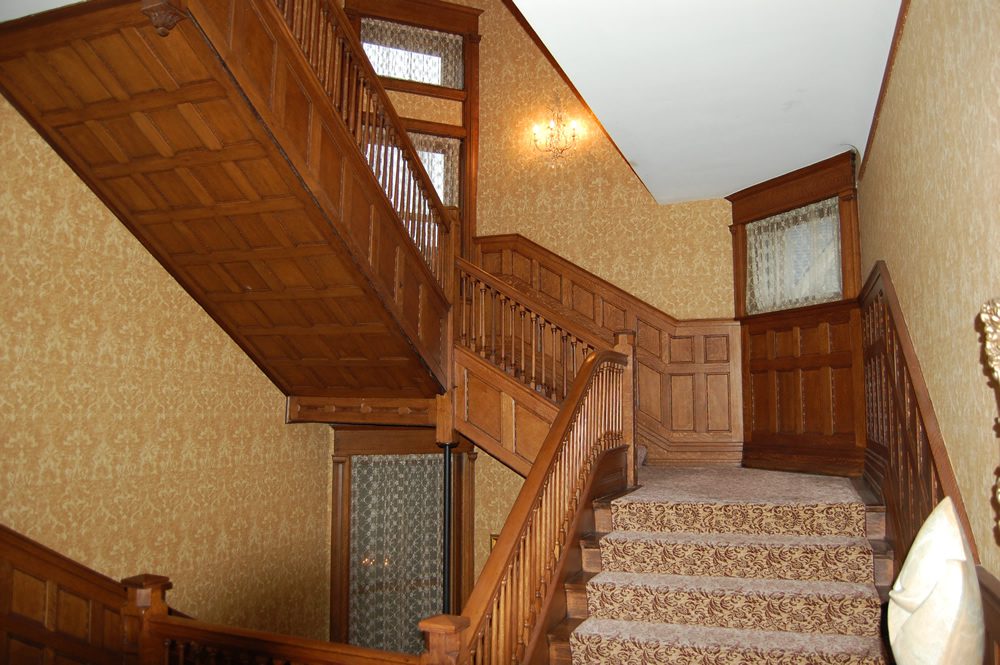
This view show the spot where Pauline and I were standing, in front of the Master Bedroom Suites.
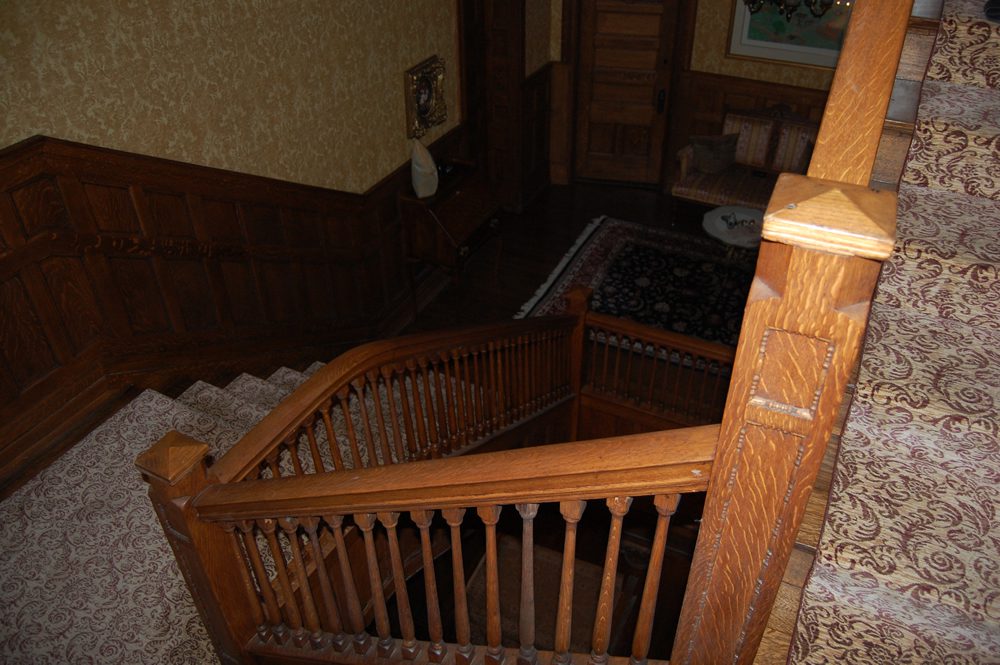
This view of the Grand Staircase is from the corridor outside of the Ballroom. This photo has the lights on.
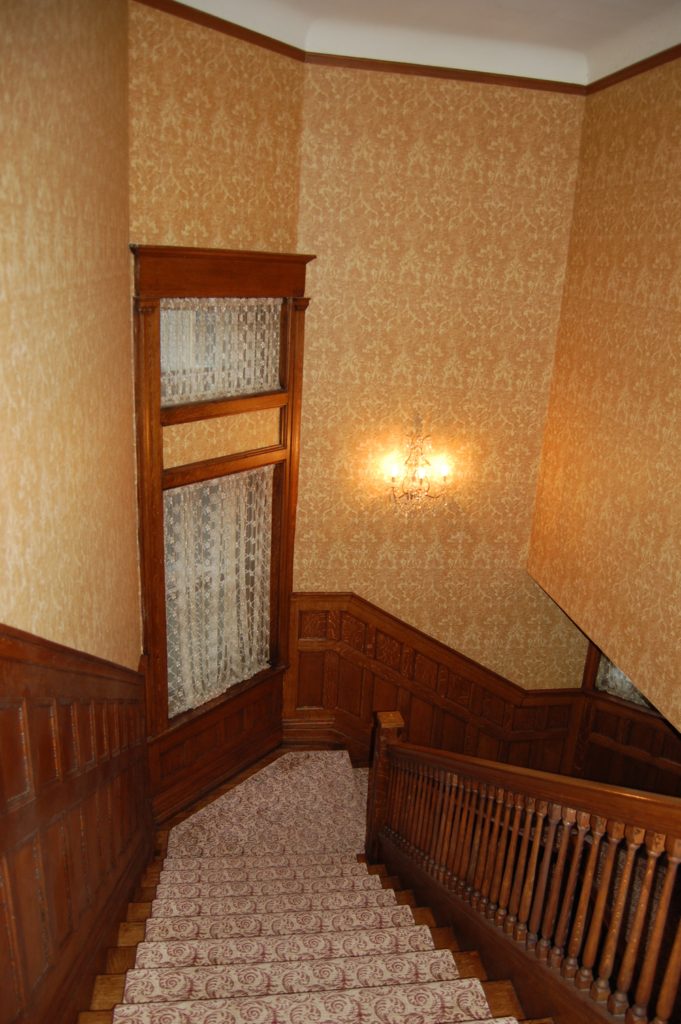
This is a view of the Grand Staircase before Pauline turned the lights on. Imagine the days of gas lights!
Morning Room
- Day Room
The Morning Room, which is a day room, is a private place to relax in the morning. It is here that the lady of the house would have morning reading and tea. Of course guests are welcome, but they are usually received here in the afternoon. The large doors with windows on either side face the south lawns and open to a large covered porch. Through the door to the left you can see the Living Room.
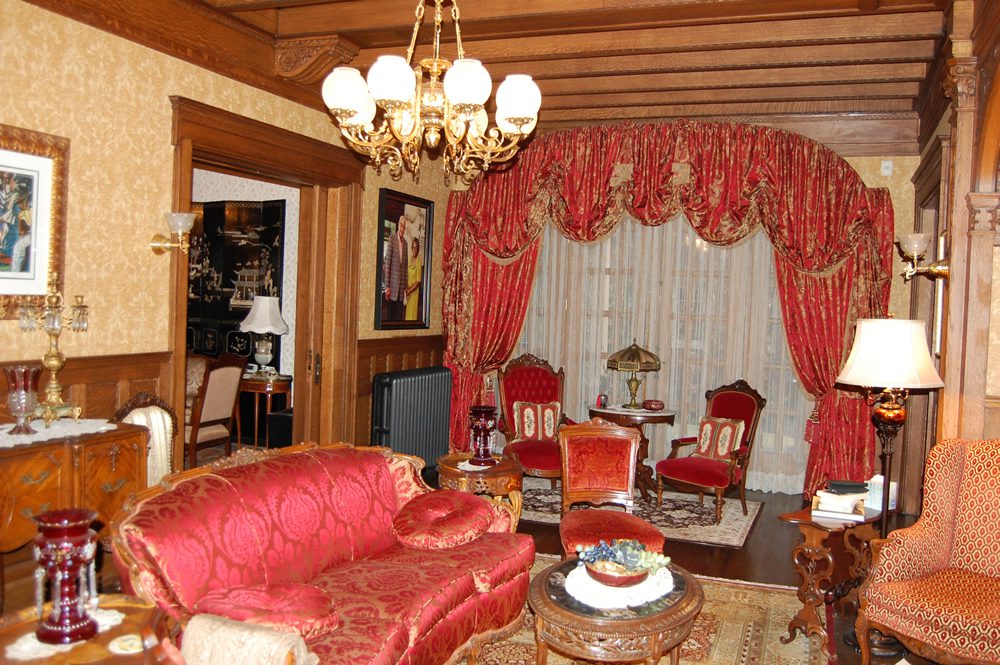
This view of the Morning Room gives you a view of the Dining Room.

Taken from the steps of the Grand Staircase, this is an overall view of the Morning Room. To the right is an alcove that contains a large fireplace with fine wood relief.

Entrance Hall
- Foyer
This is a gaslight house, not electric. It has to be understood that at the turn of the 19th century, gas was in vogue, and electricity was in it’s infancy. Thus, the rooms were smaller so as to cast the torch light. All of the chandeliers that you see in these photos are later additions. Electricity is a late comer.
We are looking east towards the front entry. At the very end and to the left is the vestibule, past the small couch. The cabinet that you see on the left with the large Chinese vase faces the elevator.
Portico
The entrance to the coach entry and portico is immediately to the left of the Grand Staircase, and leads downward.
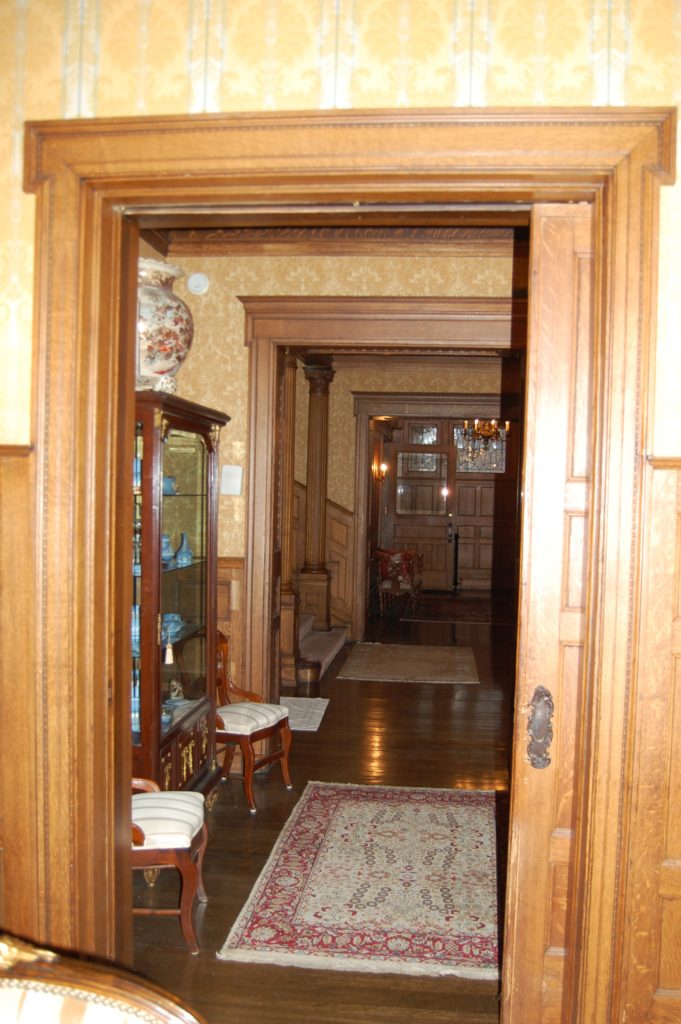
Now we are looking west towards the Parlor. I am standing in front of the Vestibule door, and the Living Room is to the left.
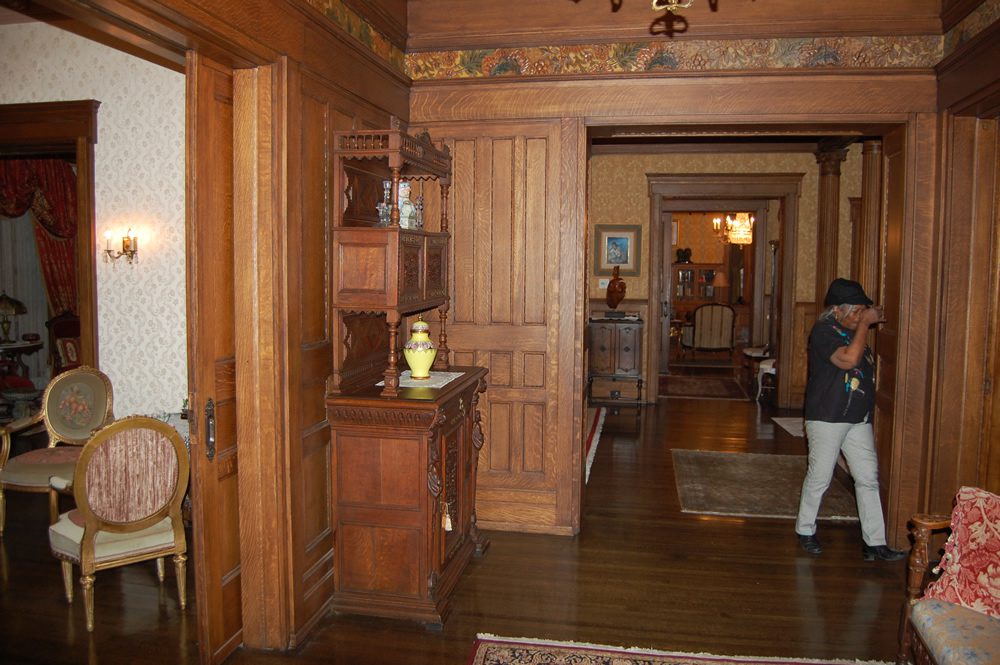
This is the Entrance Hall proper, and the door to the Vestibule is opened and directly in front of us, while the Vestibule is to the left. The Living Room is to the right.
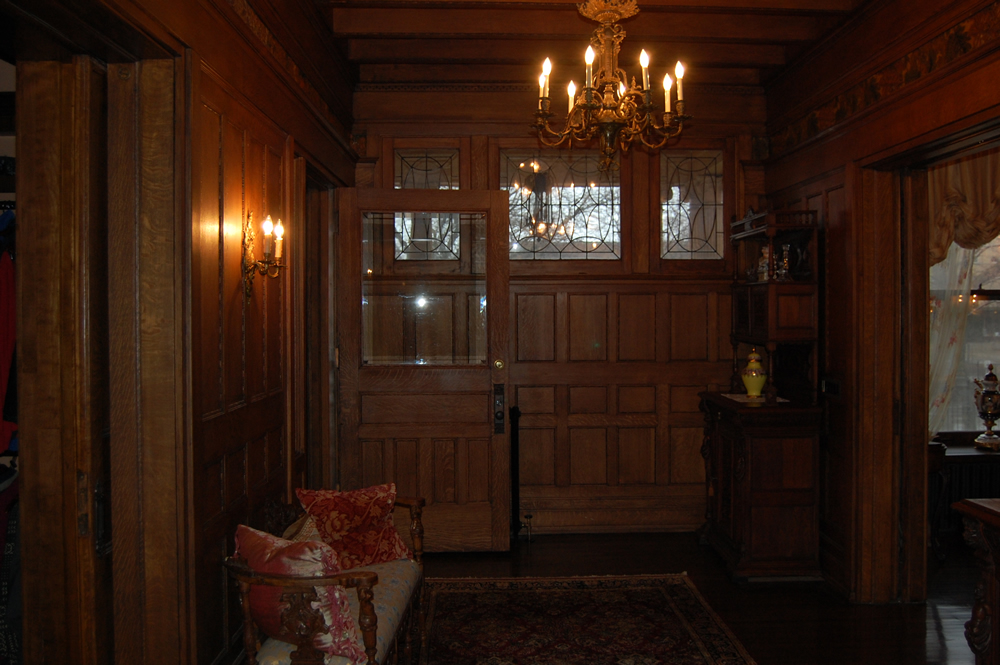
We are standing just inside the Parlor looking towards the Living Room.
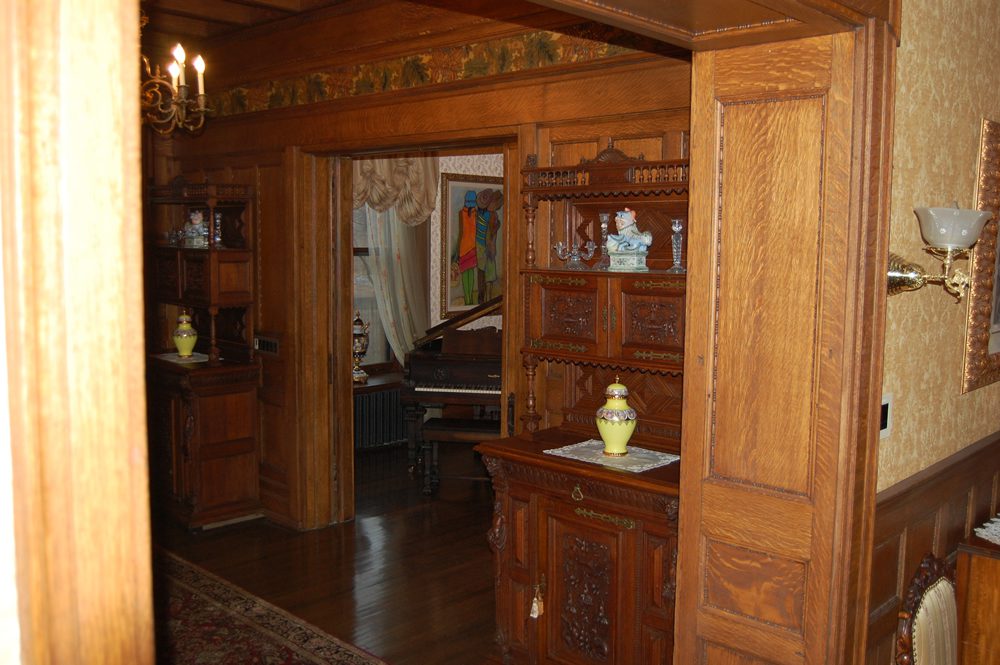
Parlor
- Drawing Room
Because the Parlor is the step-child of the Drawing Room, it is less formal. In the Parlor, I am seated with James Montgomery, surrounded by his wonderful art collection. Behind us are the cabinets that the Montgomery’s had to re-install as they were taken out. The hired craftsmen from Europe to make and install these new cabinets.
Casual
It is my conviction that this was not a library but rather a game room, because bookshelves are not behind glass doors, (unless in a museum setting of course). These cabinets were more likely to sore chess sets, card, and games for casual living. Just like the Chicago Athletic Club (CAA) on the Second Floor in back of the Lounge.
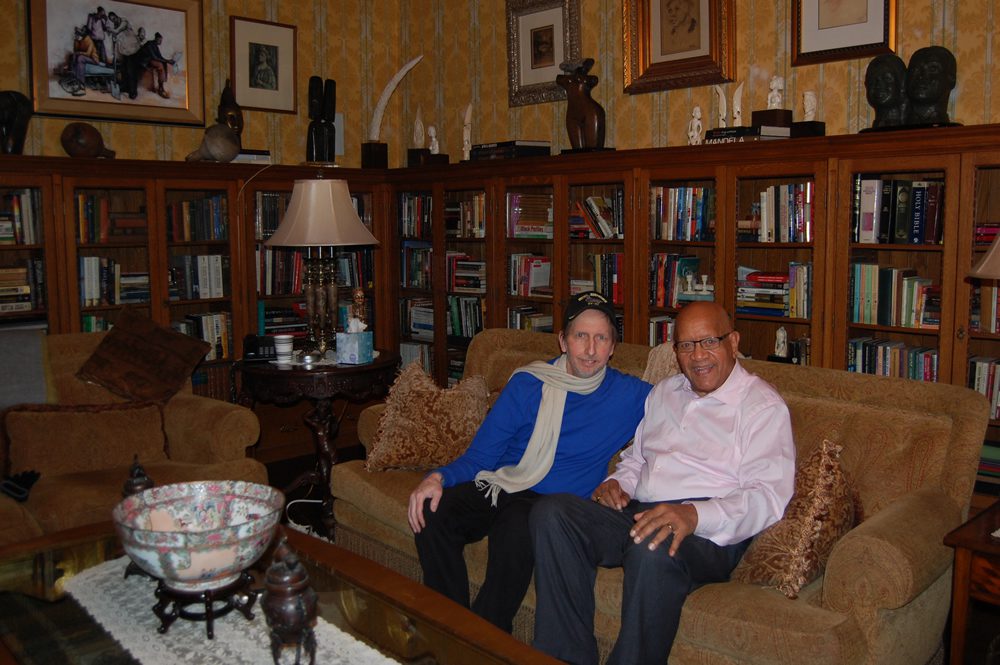
Though the door on the left you can see the entrance to the elevator. On the door to the far right you can see into the Dining Room. James Montgomery is relaxing in a chair.
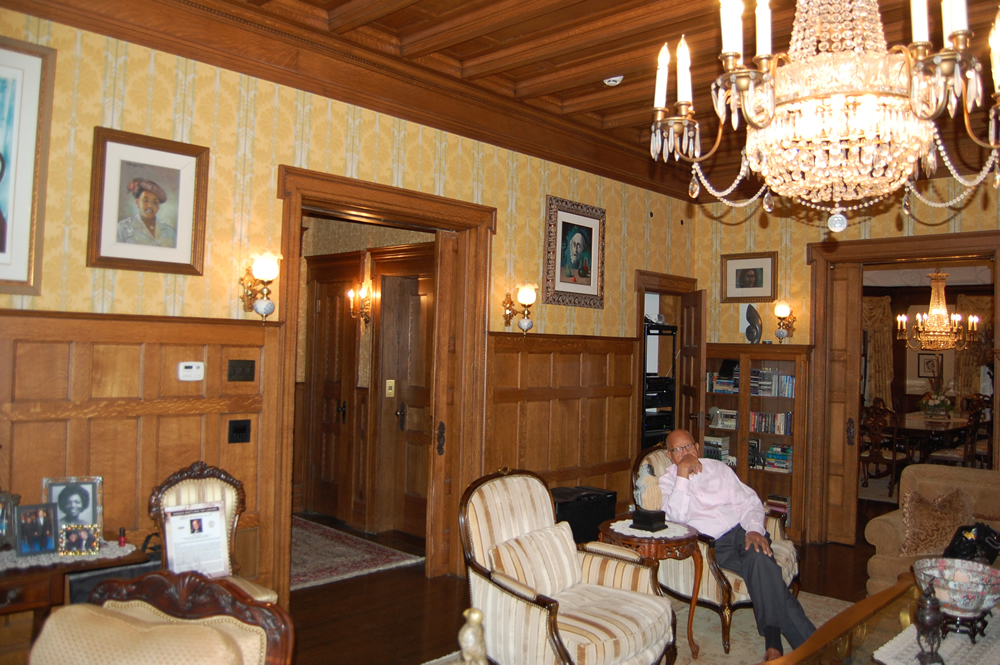
I just love the phot of Pauline, it give us a view of what a sincere and open person she is. Behind her is what at first I thought was a former Billiards Room, or Pool Room. After going though the house and reviewing the photos I am now convinced that this spot is correct as it is. But is was for cards and light conversation while entertaining. Remember, the Kitchen was in the basement, not adjacent and ultra-convenient as it is now. However, now is serves as a Breakfast Room. Because the door to the back left leads to the kitchen, the room became a natural Breakfast Room. The rear window faces west.
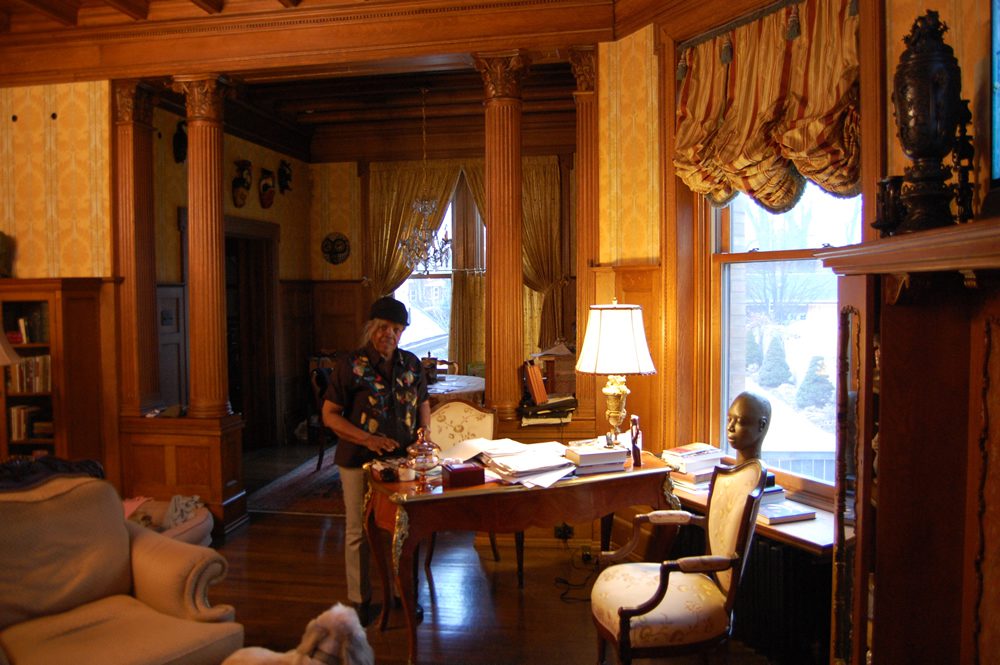
In this view of the Parlor you can see the Dining Room.

This overall view of the Parlor show access to the Dining Room on the left, and access to the Breakfast Room to the right.
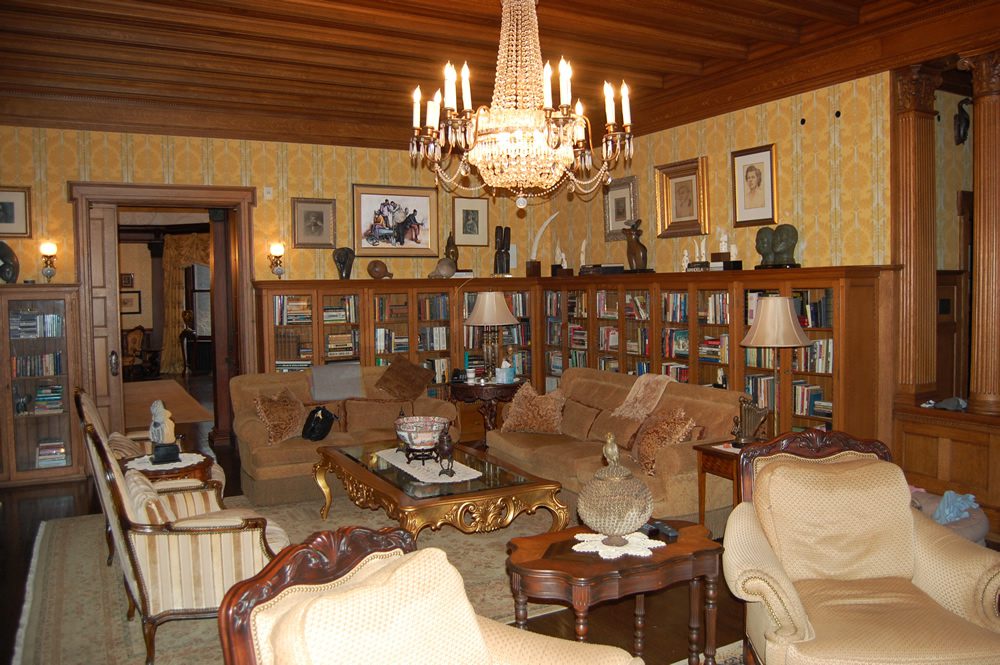
Carriage Entrance
- Coach Foyer
The Carriage Entry is quite small but a real jewel. The entry door is on the left and opens to the portico outside. Behind me is the steps up to the hall and Morning Room.
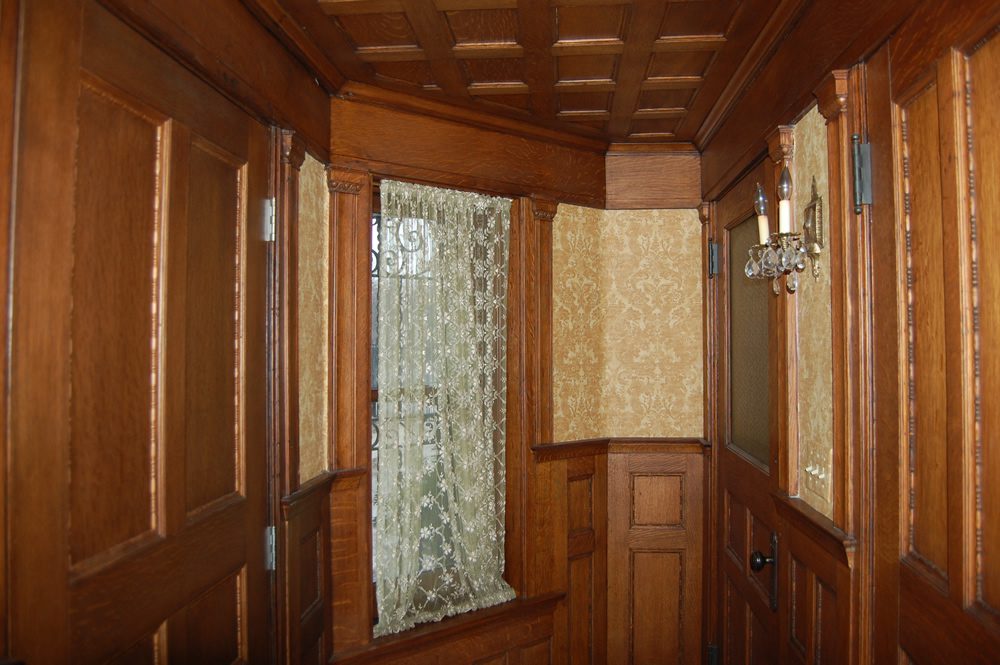
This view show the fine woodwork and craftsmanship everywhere.
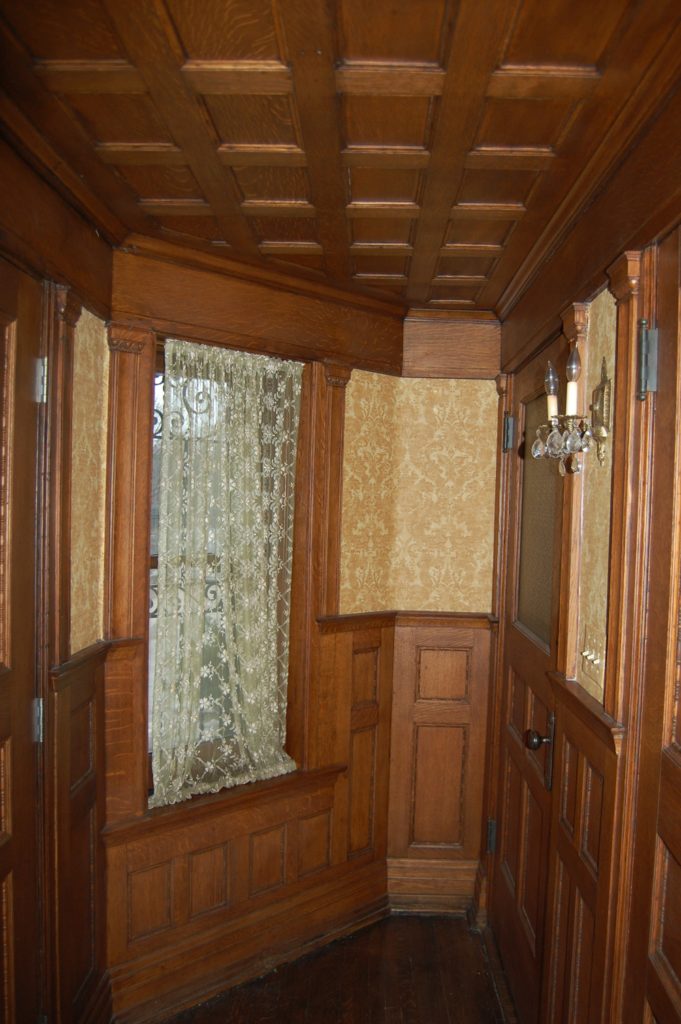
Men’s Smoking Room
- Pipe Room
This is one of my favorite rooms in the house. Because we are in a very special place, right above the portico! This is the only room of the house that is not in the central block of the structure.
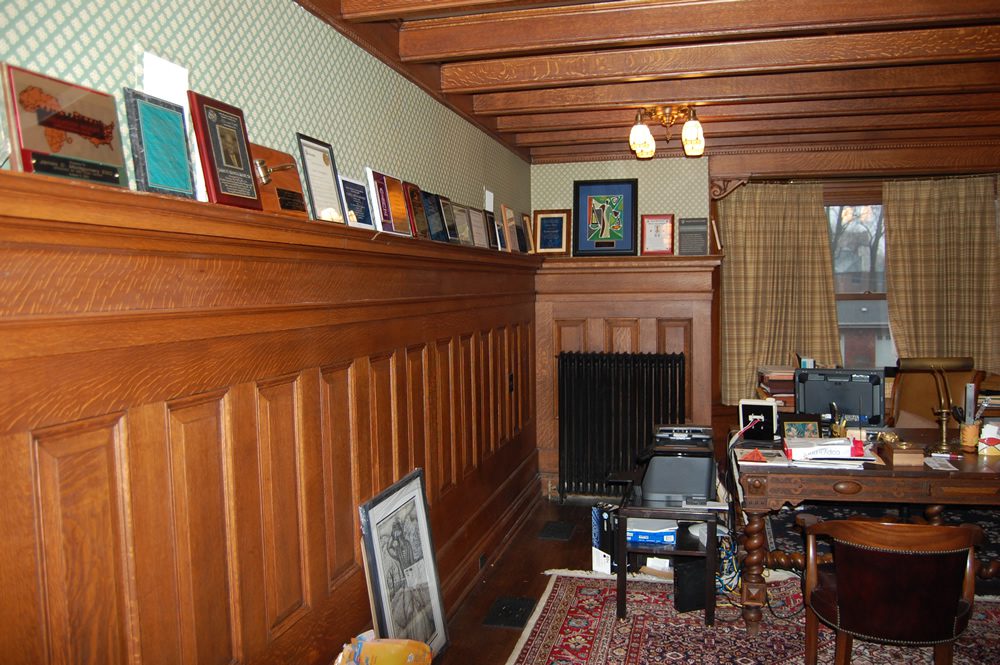
These bookshelves and drawers were installed by the Montgomery’s.
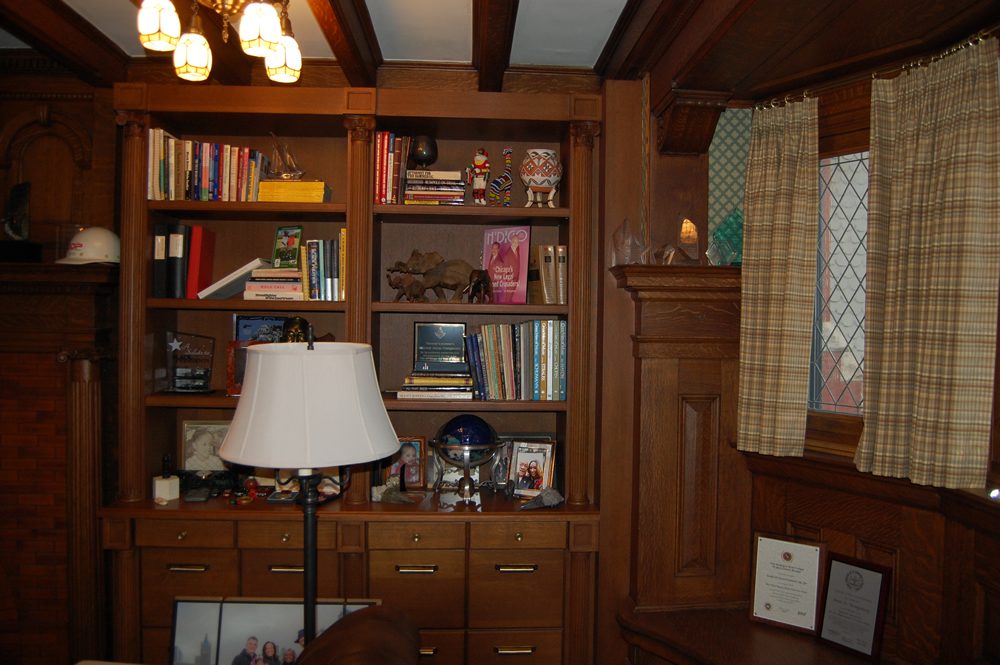
The overall feel of this room is very masculine, especially the fireplace.
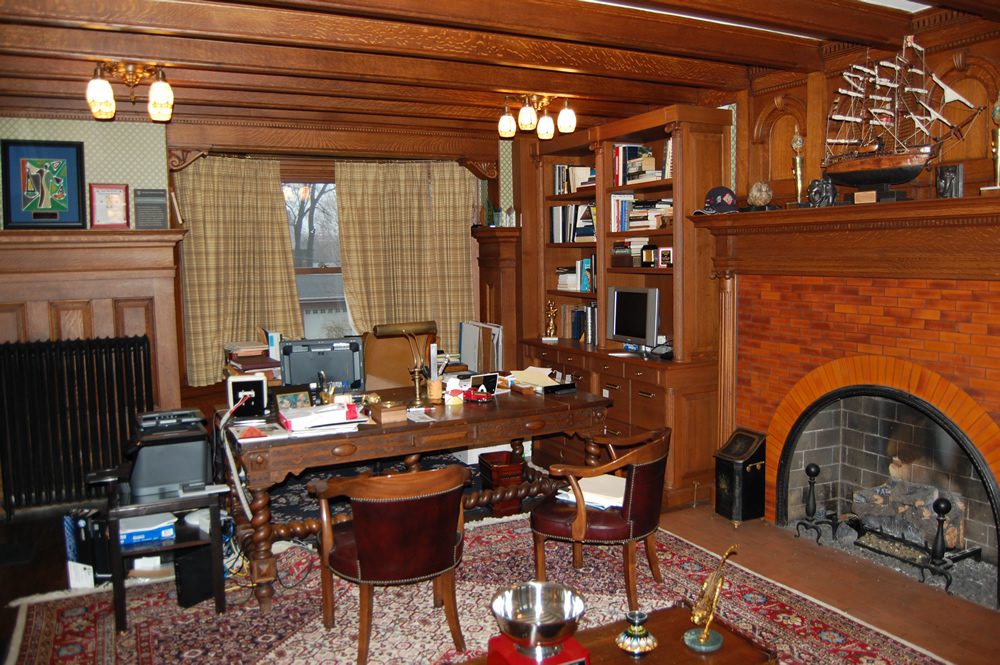
Bedroom
- Guest Bedroom
This is one of the Guest Rooms adjacent the Master Bedroom Suites.
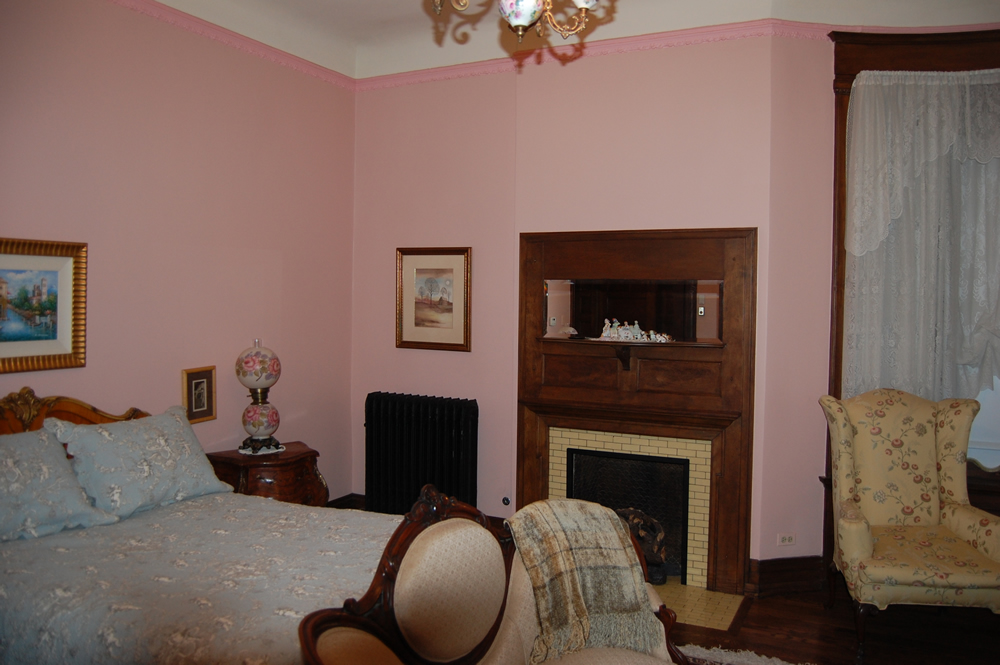
The cameo of Pauline is wonderful.
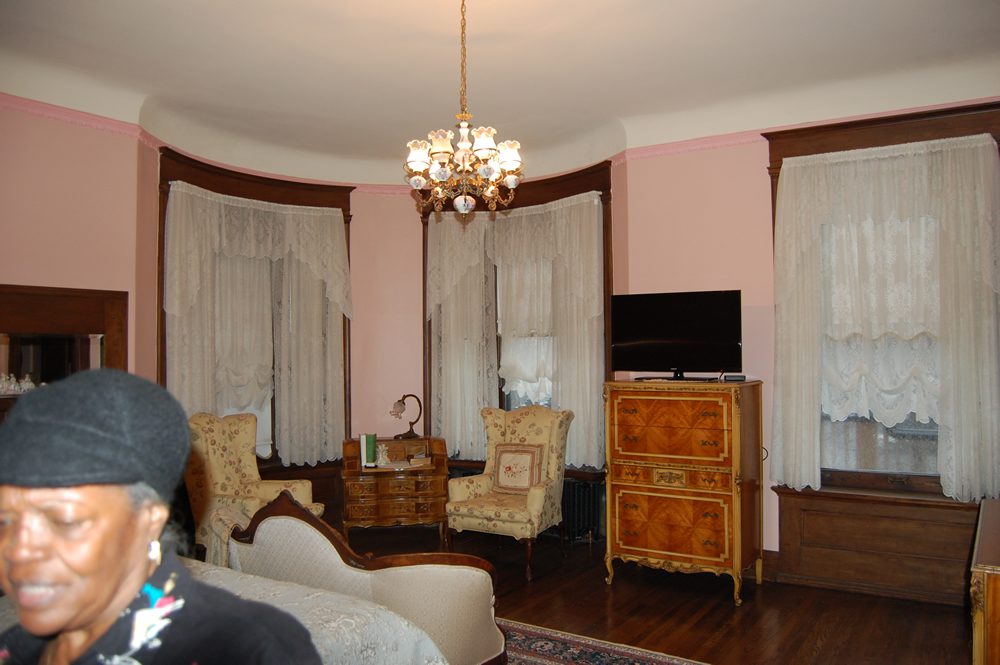
This is a small built in cabinet on the Third Floor and most likely a servant’s quarters. This space at one time was used as a pool room.
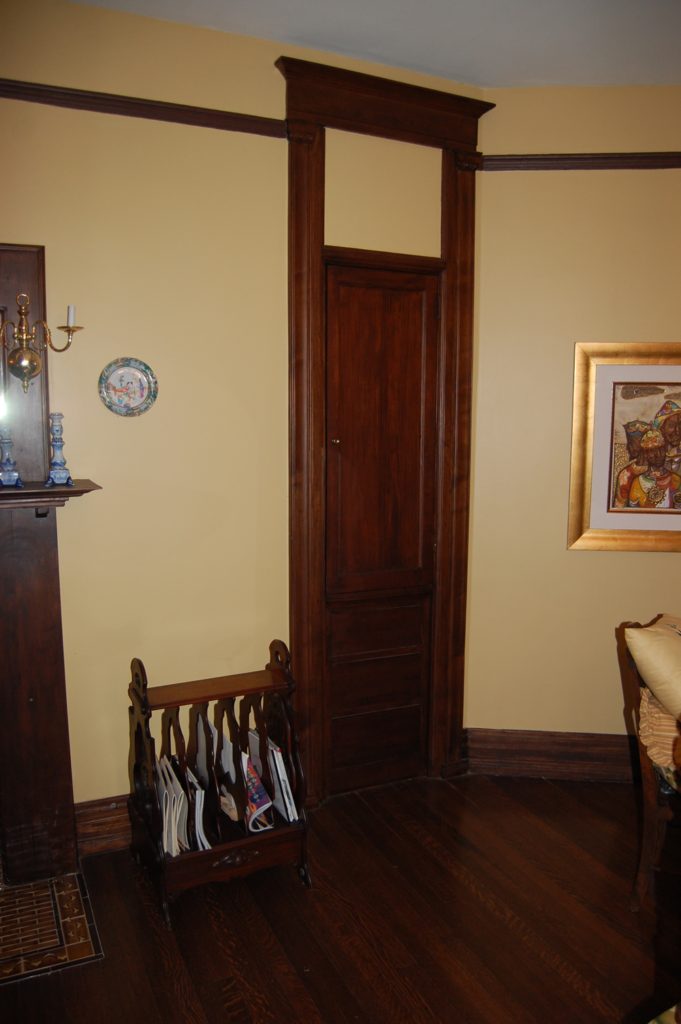
Ballroom
- Dance Hall
The Ballroom, or dance hall, is the largest single room on the house. This is a lovely and gracious space, however, in the original there were no cabinets and no coffered ceiling! The original Ballroom had murals and a stage. At a later date the stage was converted to open access platform, accommodating recitals, and other events that did not use a chamber orchestra or musical ensemble.
Grand Salon
It is my theory that as the Gilded Age waned, the era of hosting balls came to a stand-still. Because there was still a need for social gathering and events that were not dance based events, these large halls were converted to more “modern” and practical needs. Most importantly, events that needed a large space without an orchestra or band. Hence, the conversion of the Ballroom to a Grand Salon.

Coffered Ceiling
The coffered ceiling and chandeliers are magnificent! Each end of the Ballroom has a working fireplace.
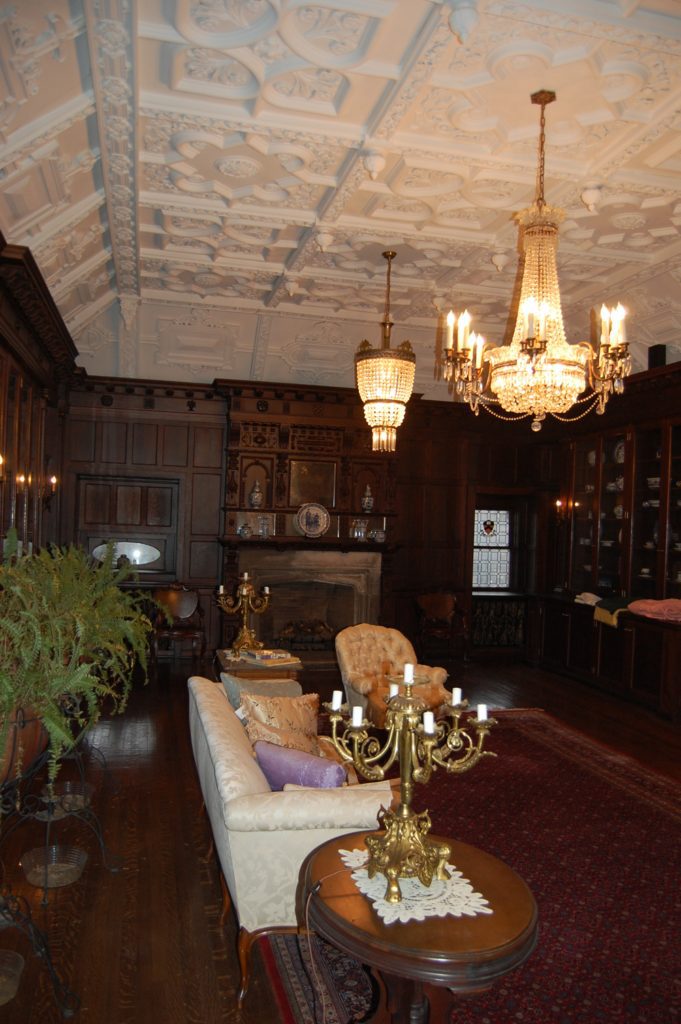
This view of the Ballroom shows the Orchestra Pit. However, it has been converted to a service station for hosting events needing to be catered.
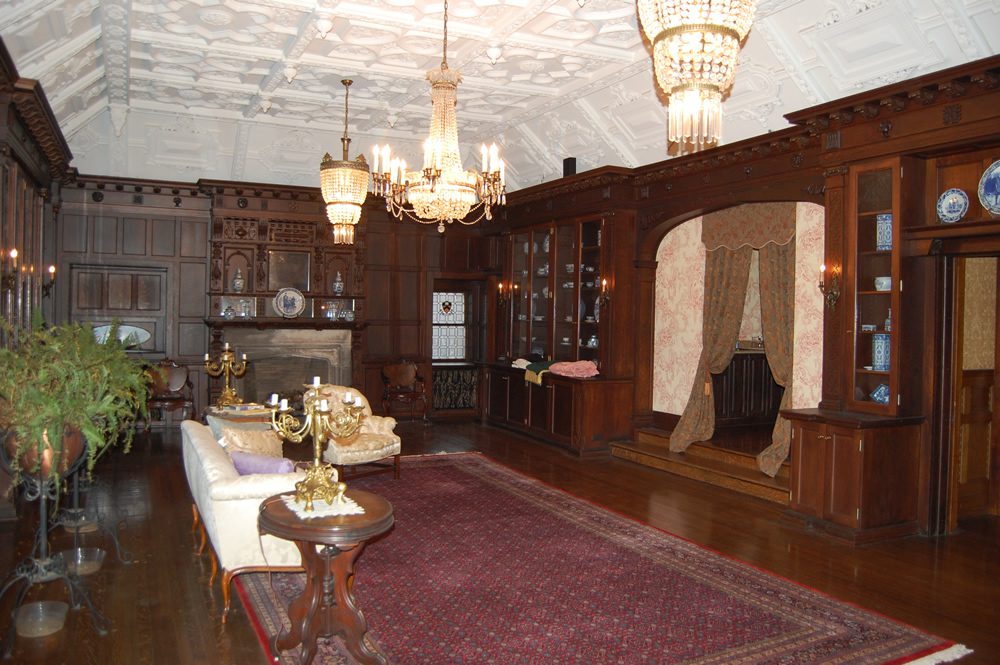
On the left are the main windows of the Ballroom and the look out east and are in the front of the house.

This splended view of the Ballroom show the details of the coffered ceiling and the tracery of the front windows.
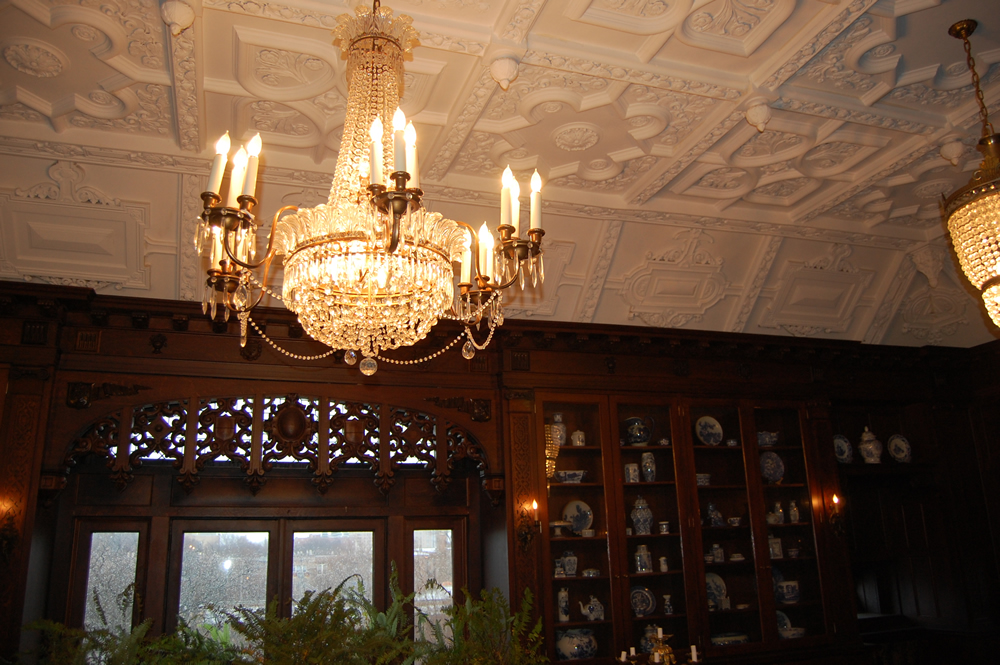
This is the fireplace on the south side of the Ballroom.

This is the north fireplace with service entry.
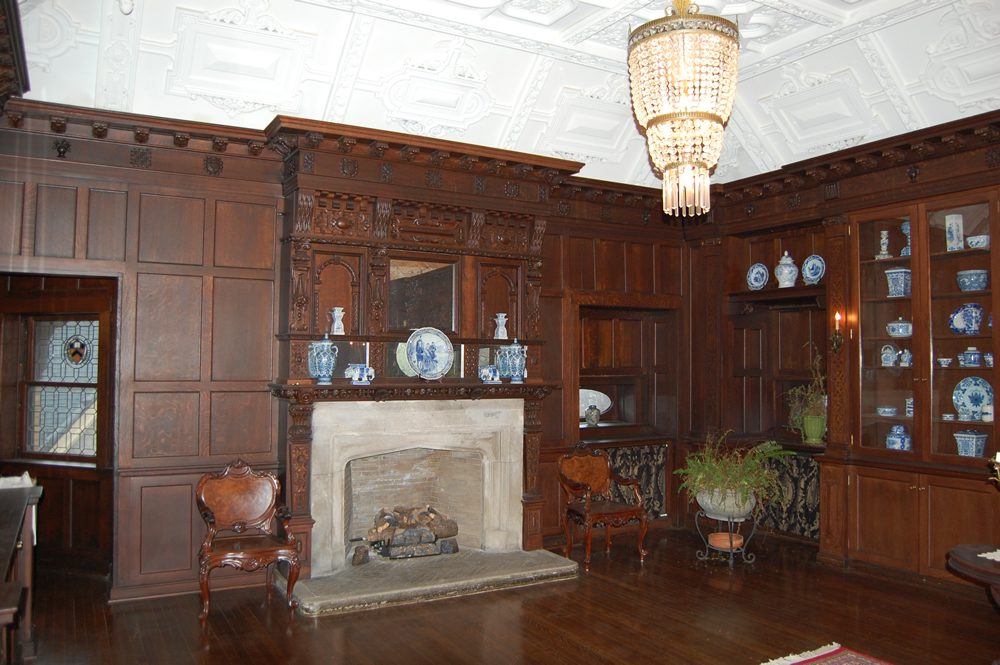
A view looking out into the front windows of the Ballroom from the service station.

A view of the sink and counter tops in the Service Room.
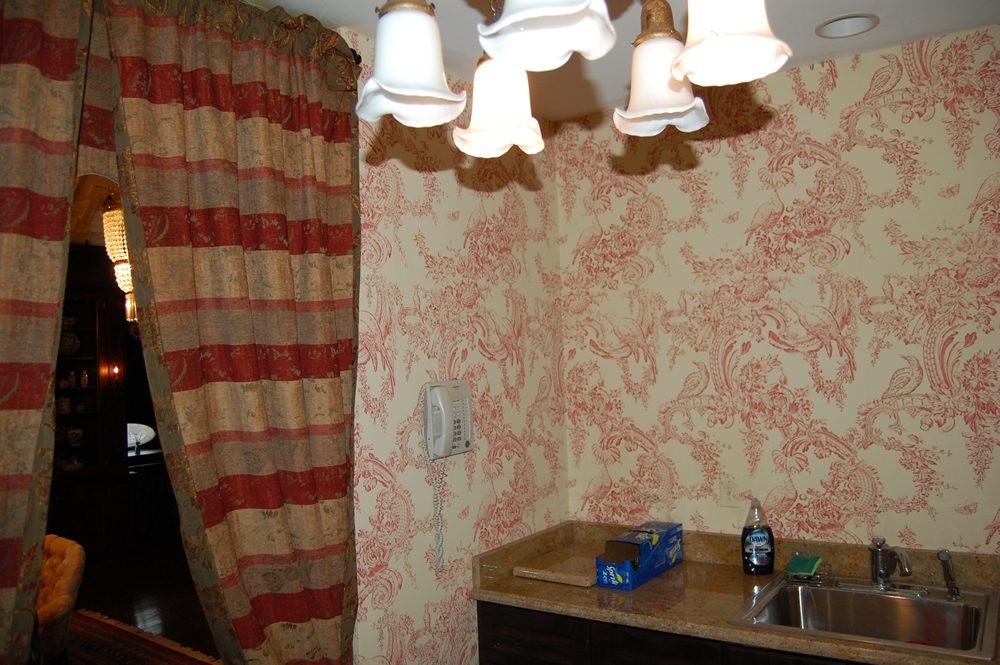
The sink and counter top with phone!
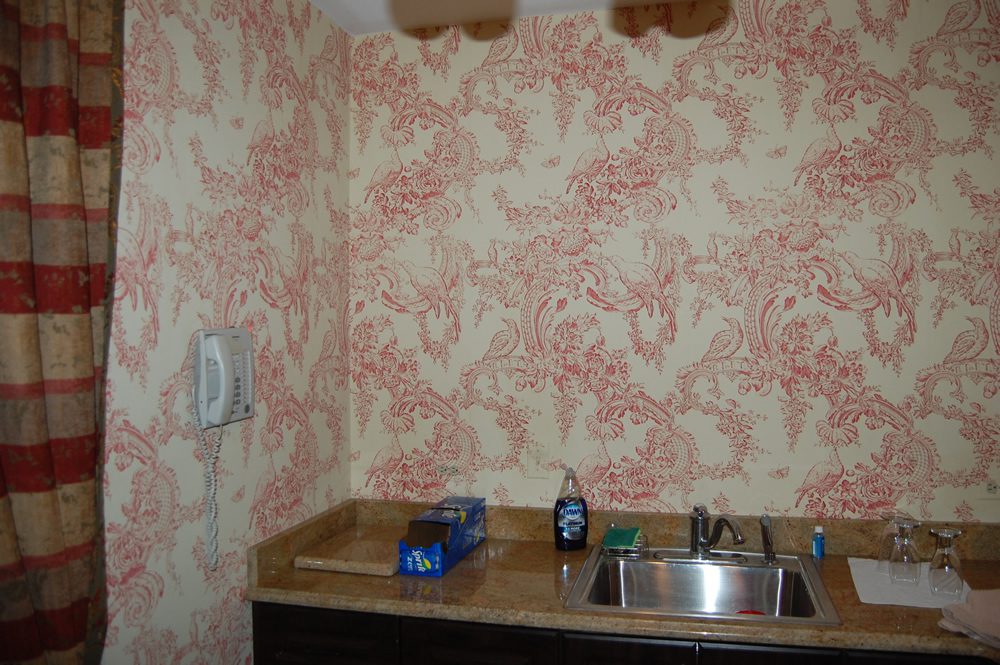
Dining Room
- Grand Salon
To me the Dining Room, which is a variant of the a Grand Salon, is the most beautiful room in the house, and there are many! This shot is taken from the Parlor.
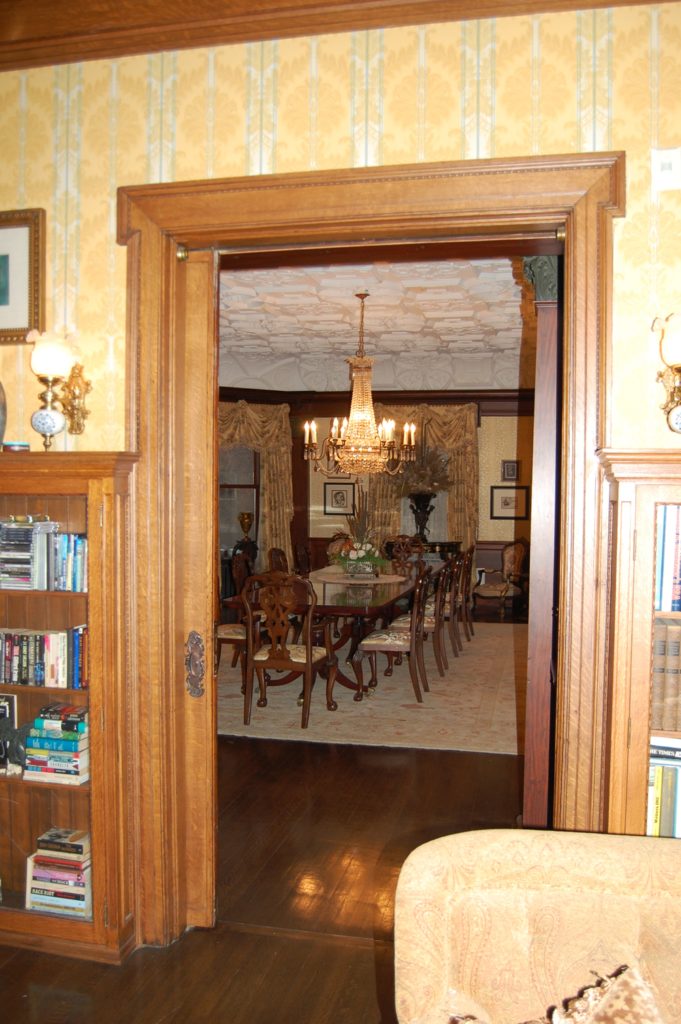
This view of the Dining Room is taking for the Kitchen area. This room was expanded by the Montgomery’s.
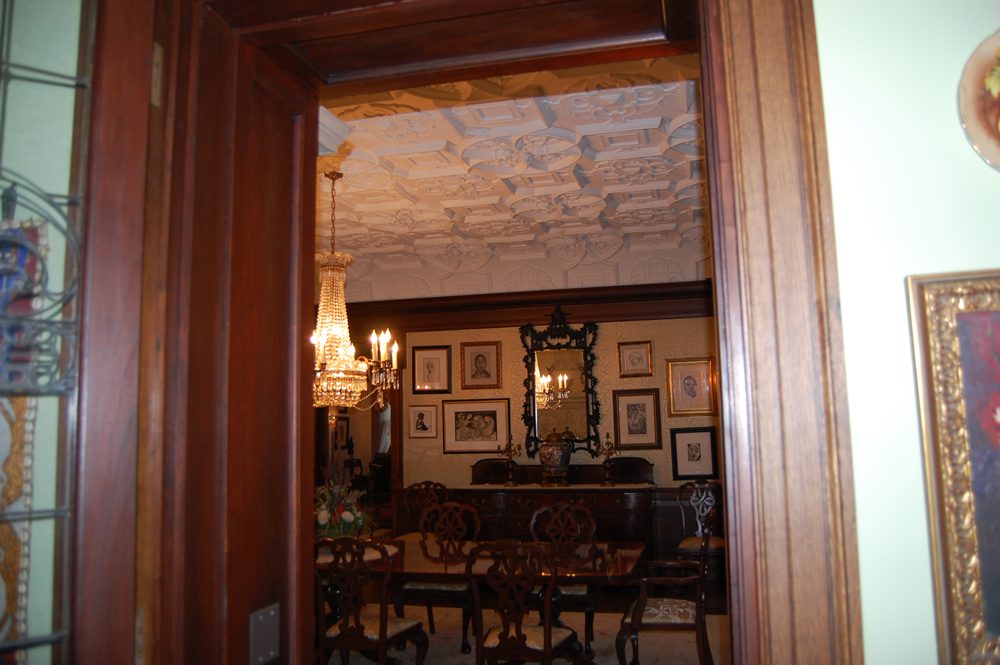
All Meals In The Dining Room
All eating is to take place in the Dining Room. At the time of this home there was no such thing as a Breakfast, only the Dining Room. The whole concept of a breakfast room is strictly modern and lacking in service. At every meal the servants set the table and the family came to eat. When you look a any episode of Downton Abbey, you will see that the Crawley family is always seen eating in the Dining Room, day or night. When Lord Crawley is at work in his Library, never once to you see him eating or drinking.
This room demands service and it gets it! When the house was built the kitchen was in the basement and all the hot platter had to be covered and brought upstairs (via the back stairs) to the Butlers’s Pantry and adjoining service rooms.
China
Please notice that are no breakfronts or any kind of china, dishes on display ~ Thank you! China and silverware belong in the Butler’s Pantry. The concept of putting dishes on display is banal. There should only be two other pieces of furniture aside from the table and chairs, and they are the server, and the buffet. The server is crucial in that it is the key landing point from the Kitchen to the Dining Room.
The Server
When food comes out of the Kitchen it is immediately placed on the server, with is an elegant piece of furniture usually located close to the Butler’s Pantry door. Because the maid or butler sets the food server, he or she then organizes and puts each plate in order. Most importantly, after the plate is in order it is ready to be served to those that are dining. Most importantly, plates for the table never come directly out from the Kitchen to the table ~ never!
The Buffet
The buffet, like the server on a larger scale, is the station point for larger vessels, especially foods like lasagna and ham. These need to be set to porting my the butler and then served to those that are dining. In a strict household the butlers stands at attention at all time during the course of the dinner, and oversees all the activities of the dinner hour.
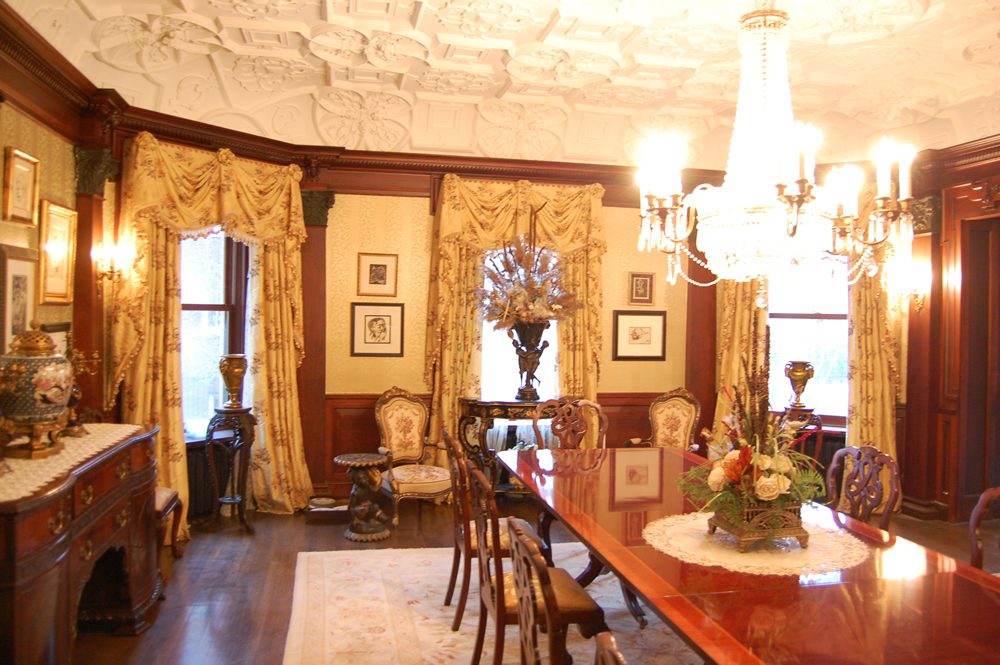
Behold this incredible fireplace! This is stone masonry top to bottom with all the reliefs. To the left of the fireplace is the service room outside of the Kitchen.
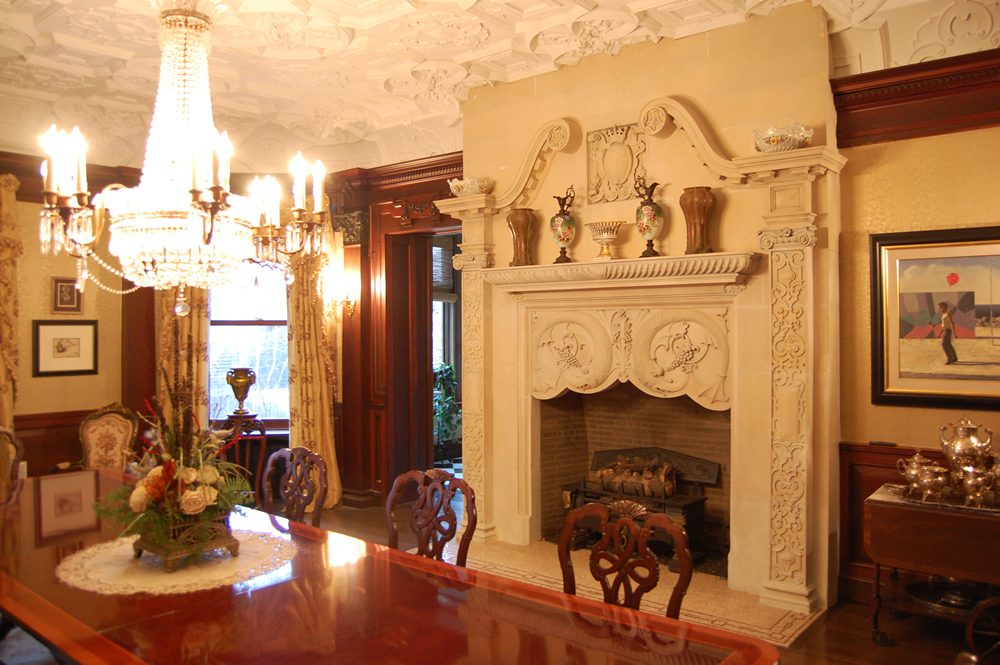
Kitchen
- Galley
This room should not be here for in the beginning it was in the basement! All of what you see is later addition, so it is most difficult to say much about it. It is undoubtedly gracious and does the job! The room that I am standing in, is between the Kitchen and the Dining Room. Because it has to have served as some sort of resting station for food preparation, it is close to the Dining Room.
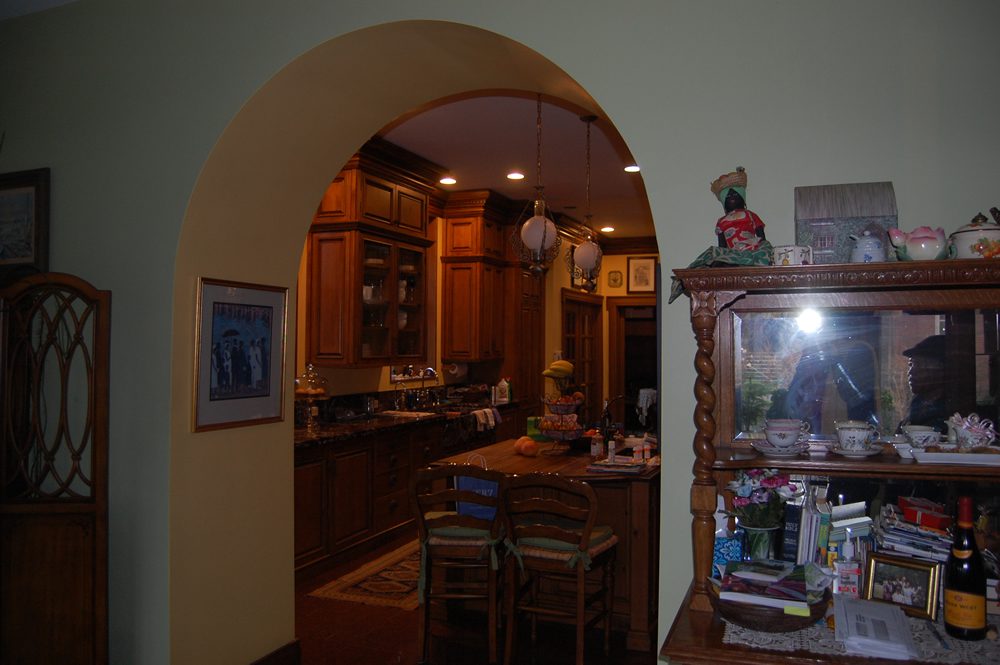
This door was move from the Kitchen wall to the Dining Room Wall. We are still in that small service room next to the Dining Room.
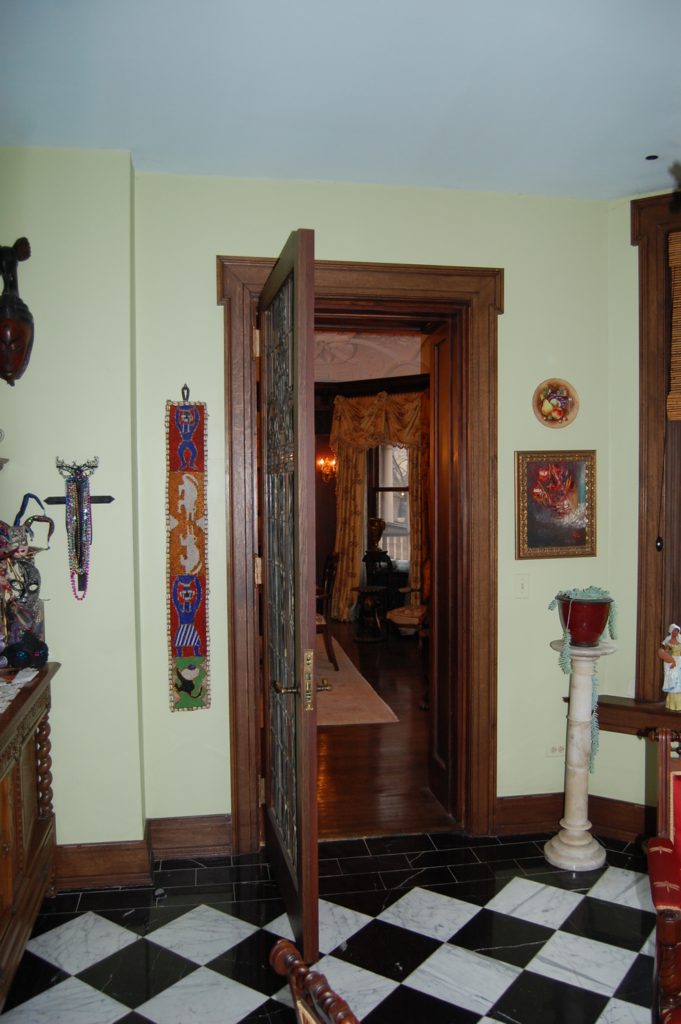
Elevator
- Lift
This elevator is original to the house! However, at the time it was made it was hand operated. Because the servants had to operate the pulleys to take the car up and down, it was not in use at a moment’s notice.
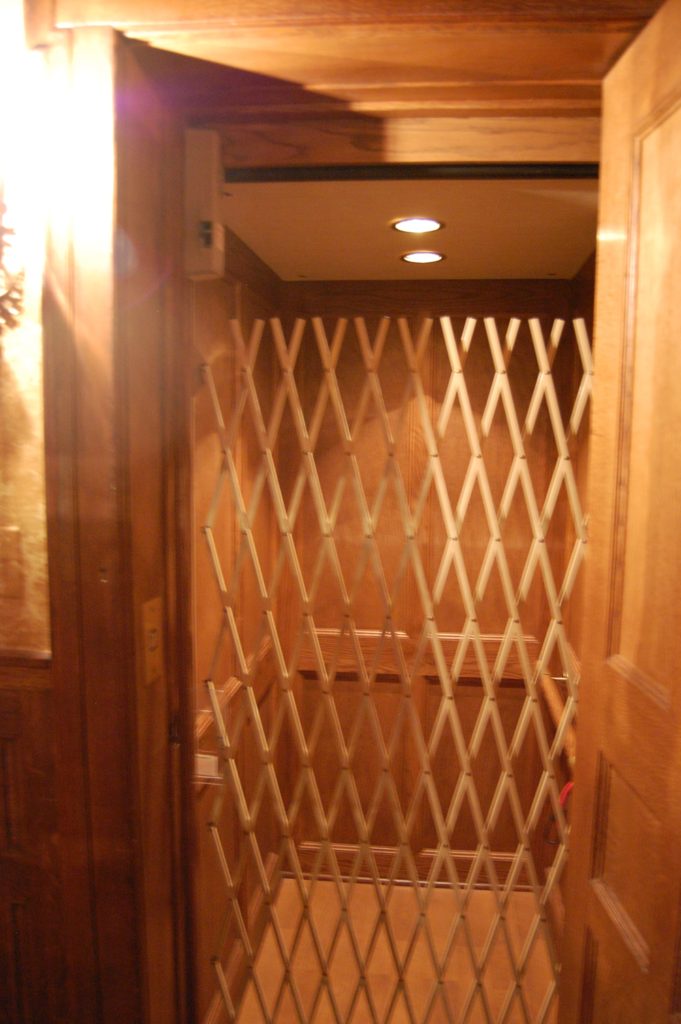
Because the elevator is large enough to hold a wheel chair, the house is handicap friendly.
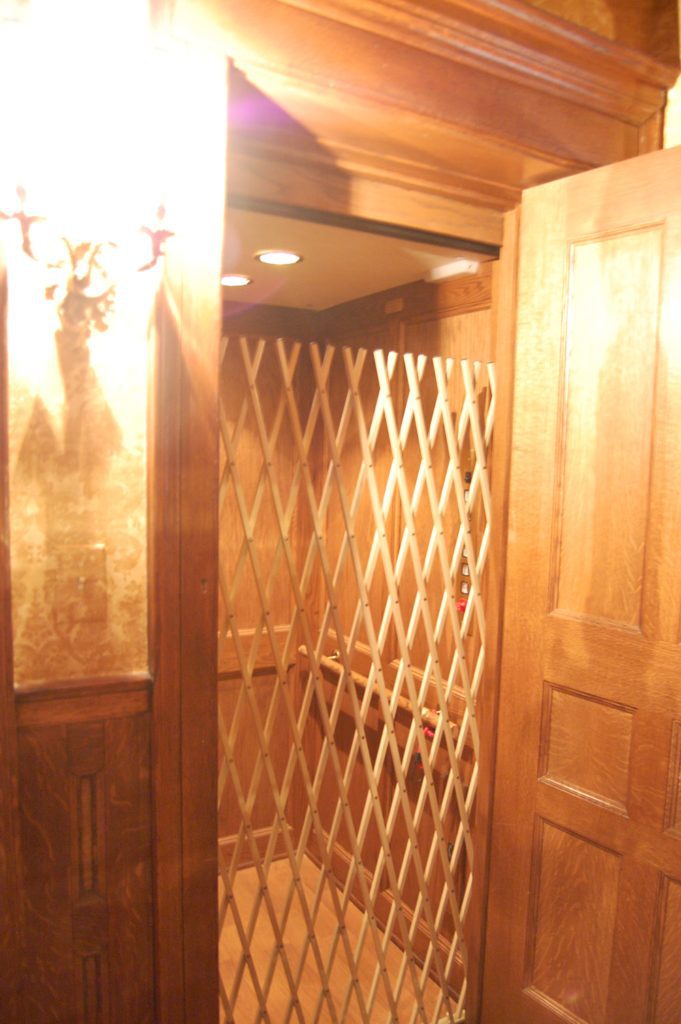
Saying “Goodbye”
- Au Revoir
As I left, Pauline let me borrow a photo-album of the Goodman Mansion in it’s early years. Most importantly, I told her that I will make scans of it along with a CD for preservation.
Rather than say “goodbye” I would like to say au revoir, for that implies a return. It is always difficult to leave the company of people that you love, and I so love these dear and precious people, James & Pauline Montgomery.
Thank you James and Pauline Montgomery!
Condren Galleries Ltd.
- Fine Arts Gallery
Condren Galleries is my online Website where I display and sell my artwork as well as write article on various topics germane to my education and expertise.
Stephen F. Condren
- Artist
As a child I could always draw and I will never cease from drawing or being an artist.
Alt Image Tag
Goodman Mansion Chicago #264Z, home of Attorney, James D. Montgomery.
